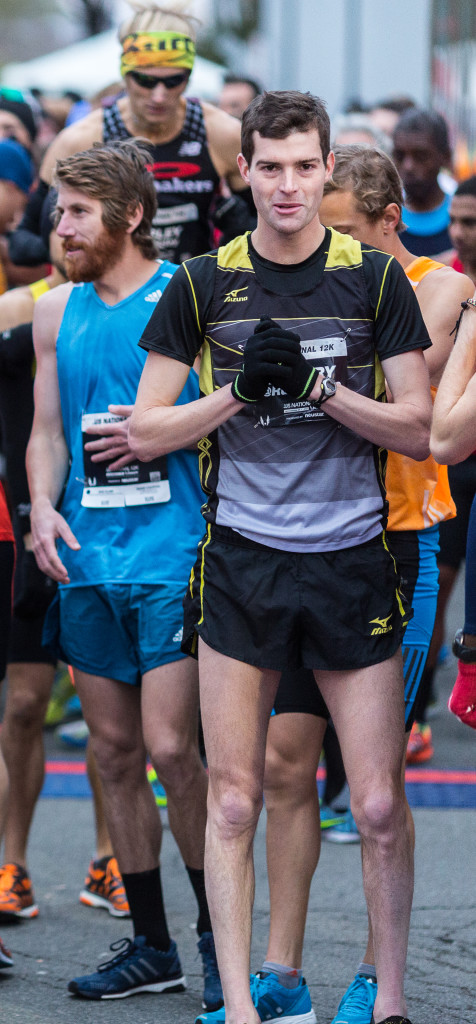
It wasn’t a bad showing. He had placed fourth at the inaugural U.S. 12k championships, the culmination of the 2013 American professional road racing circuit.
For Christo Landry, who runs professionally for Mizuno, that year included three more top-five finishes in U.S. championships, including in the marathon, held just six week earlier. But this race was special for him — because the Northern Virginia native was racing on his home turf in Alexandria. “This race exceeded all of my expectations,” he said.
You have to wonder, then: Imagine if Landry had known what was coming in the next year.
Landry races at 9:15 pm. eastern July 1. NBC is broadcasting the trials, streaming them here and RW Advanced is live tweeting the 10k.
Imagine he knew, in April, he would return back to this place he still calls “home” for the Cherry Blossom Ten Mile Run, another national championship, and – as he would take the lead among Americans – hear spectators say things like: “Wait a minute, was that? Go Christo!”
Yes it was. The tall, lanky kid who led the Thomas Jefferson High School for Science and Technology to a state cross country title was performing on the big stage.
The race organizers planned to have separate tapes at the finish line for the American and overall winners, unless there was a sprint finish. In the last mile, wanting to capture his first national title in style, Landry let an East African he’d been running stride-for-stride with zoom ahead of him so the tape would be there.
At the next national championship, a month after Cherry Blossom, Landry tied the American record for 25k. After the race he drove back to Ann Arbor, Mich., so giddy, so pumped beyond belief, that he belted out whatever classic rock tune came over the radio. And in the morning, after only a few hours of sleep, he reported for drug testing, confirming that USATF rules do actually allow for professional runners to experience a very rare night out on the town.
Then it would be Independence Day, and Landry would be in Atlanta for the Peachtree Road Race, host of the national 10k championships.
Coasting into the lead, he’d think to himself: ‘Are we going that fast? Because I’m feeling good.’
Imagine, in Alexandria that day, if Landry had known that the slow-but-steady success of his first three years on the national road racing scene was fast approaching a tipping point.
Three national titles in one year.
***
About a year later, the day before the second running of the 12k championships, we had lunch at the Railstop Gastropub, at the Crowne Plaza hotel in Old Town Alexandria. I was concerned, for Landry, that the menu only seemed to offer items like burgers covered with fried eggs. “This is fine,” he assured me.
At 6 feet 1 inch, Landry is on the taller side among professional runners. I’ve seen many lean, hungry-looking runners sport dark shadows under their eyes during periods of hard training, but Landry’s look more like tattoos. His training log, as it happens, is full of 130- and 150-mile weeks and marathon-length-and-longer long runs.
As for his personality, Landry — and I agree with his coaches and friends on this point — is the following in roughly equal parts: pure jokester; the most serious person you’ll ever meet; and hyper-logical all the way through.
He was drawn to running “because I was good at it,” he said. “That’s what started me at it. I’m a very competitive person, and you can’t be competitive in every aspect of life — that’s just not how the world works. So you pick and choose your spots, and running was the sport I chose.”
His 2014 breakthrough, he said, was no mystery, either.
In high school and at the College of William and Mary, Landry was injured about as often as he was healthy. Rather than build fitness year by year, he would get injured, cross train like an animal, complete a crash course in training, repeat.
This didn’t stop Landry, now 28, from leading TJ to a state title. It didn’t stop him from becoming an All-American in college, either.
But it always left him wondering … What if I could just stay healthy?
For all of the high points of 2014, though, Landry, when we met, was also bouncing back both physically and psychologically from his last race, the Chicago Marathon, where he was 13th in a disappointing personal best of 2:14:30.
Making matters brighter, Landry’s second USARC Running Circuit title was officially in the bag. Regardless of how he did in the 12k – regardless of if he even finished – he would receive a $25,000 check for winning the series.
His goal for the 12k, he said, was “to go out there, compete, see what happens – anything I do is icing on cake.”
***
Landry comes from what he describes as an “athletic family.” His mother ran track. His dad played basketball and volleyball. His brother, to give you an idea of the endurance genes that run in this family, ran about 9:15 for two miles even though he could only train every other day.
After setting a kindergarten record for the mile in nine-plus minutes, Landry first went out for cross country in middle school at Falls Church City Public Schools.
But he liked soccer — a spring sport in Virginia. And while that at least opened up the door for high school cross country, the freshman-year Landry signed up for golf instead. When winter came around, he went out for indoor track, only to get in shape for soccer.
After flunking out of 500 meters, he turned to longer distances, breaking five minutes on a slow track.
“I don’t think I ever had a kid do that; it’s pretty rare,” said Matt Ryan, who coached cross country and track at Thomas Jefferson from 1997 to 2009.
There was no big speech needed to convince Landry to skip soccer and set aside his golf clubs. Landry got the message on his own.
“By the end of my freshman year outdoors,” he said, “I was running 4:30 for the mile and figured, ‘Yeah, I should stick with this.’”
It was the early 2000s, and the Northern Virginia high school scene, with runners like Alan Webb, who would become the fastest miler in American history, was experiencing something of a renaissance.
This also was true, in a sense, of TJ, a state magnet school that grooms its students for careers in science, math, and technology.
The 2002 team, which would win a state title, included a junior-year Landry; Keith Bechtol, who was a year older than Landry and would also go to William and Mary; Chris Mocko, who would run at Stanford; and Brian Hanak, who would run at Yale.
“My comment usually about the ‘02 team,” Ryan said, “is that my daughter could have coached them to a state championship.”
Landry considered Bechtol and others in the class above him as his mentors, he said.
“Keith,” Ryan said, “was very much the taskmaster; Christo was more of an extrovert.”
“There was an understanding,” said Bechtol, “that to win a state championship as a team, we needed team depth, and all the training and workouts were geared towards that effort.”
To that end, the team not only trained together – “we started doing everything together,” Mocko said. “We went to summer camp together, trained together in the off-season … shared pre-race meals together — we were around each other all the time.”
School. Practice. Dinner and homework. Sleep. “That was pretty much what I did,” Landry said.
Ryan added: “[Landry] may have been slightly underdeveloped physically, but mentally I was probably having conversations with him in the spring of his senior year” – while he was establishing himself as one of the top prep runners in the country – “that a college coach would be happy to have with a senior at that level.”
Bechtol, by the way, is now an astrophysicist searching for the highest energy particles in the universe.
He’s also run 2:16 in the marathon.
***
Landry struggled in the transition to college running. “I was getting my butt kicked,” he said.
In his freshman cross country season, while most of his William and Mary teammates raced at NCAA Pre-Nationals, Landry raced a home invitational meet.
He finished second, earning a spot on the conference team. There, Landry, again, finished second, earning himself a spot on the team for regionals.
At regionals, Landry finished seventh and qualified for the NCAA nationals. At nationals, Landry made All-American.
Fast forward to his senior season, when Landry was able to improve upon that result.
But much of the time in between was frustrating, he said. “I basically found a way to get hurt every winter.”
In his fifth year, Landry earned a master’s degree in accounting. In his sixth year he completed a year towards a Master’s in Business Administration. That winter, he of course got injured.
“I said, ‘This can’t be it, there’s more left. I know I am better than this.”
Then-Tribe coach Alex Gibby seemed to know it, too
“I wouldn’t call it a do-over,” he said, of the opportunity to coach Landry after college, “but it was nice to get some extended time with him to correct some of the things that weren’t identified early.”
Landry planned to stay in Williamsburg. But when Gibby took a job at the University of Michigan, Landry followed him there.
“That turned out to be a lifesaver for me,” Landry said. “Moving up there, setting new rhythms – it’s where the [weights staff] figured out what had been ailing my knees for the past few years: my hips were out of alignment.”
“Knock on wood,” he added, “but it’s been four years now and you can see the results. Every year you are building on the past instead of starting from scratch every year.”
***
In the 2014 12k, Landry finished eighth in a more competitive field. For winning the series, Landry was not only given a check, but a big trophy-slash-road sign that he held up proudly and more than once described as sweeeet.
A month later, Landry was named the USATF men’s long distance runner of the year. That same month, American runner Mo Trafeh received a four-year doping sanction and had to forfeit all of his results after January 1, 2012.
Landry, we would learn, did not win his first national title in Washington, D.C., or tie an American record for 25k. Because of Trafeh’s disqualifications, Landry won his first national title in 2012, at 15k in Jacksonville, Fla., and the American record is now all his.
On Dec. 19, Landry would tweet: “Glad that the cheat is being removed from the books. There is no place [for] drugs in our sport. Next step: stopping EPO users in routine testing.”
Landry’s drug, it seems, is not getting injured. The question is: How far can he go if he stays on it?
When Gibby took a new job in Charlotte, N.C., Landry upped and moved again, setting them for up an 11th year that’s all part of a long drive towards making an Olympic team in either the marathon or 10k.
Landry’s sweet spot — his results will tell you — is somewhere in the middle of those distances.
Gibby, however, believes — though “it’s probably two or three steps ahead of him” — that Landry will have his greatest success in the marathon.
“I think for young distance runners,” he added, talking about Landry’s focus and drive, “if they don’t understand it’s a long-term commitment, I think they’re missing the point.”
This article originally appeared in the Spring 2015 issue of RunWashington.

Stephanie Garcia doesn’t have time for a nap, and she likes it that way.
She typically wakes up for a sunrise breakfast before her 9 a.m. practice. After a few hours of running, dynamic exercises, and hurdling drills, it is time for lunch. After lunch, Garcia seeks out a massage, a chiropractor, or physiotherapy before heading to a second practice filled with more running, a weight session or a pool workout. If there is indeed a nap in there, the 27-year-old professional runner — a steeplechaser — doesn’t mention it.
“I’m always someone who likes to have extra projects,” she says when reached on the phone in March, at her training base at Furman University in Greenville, S.C. “But this year I’m really trying to focus on recovery and staying home.”
Her coach, Robert Gary, confirms this tendency in Garcia, describing her as a “confident worrier.” She is always “trying to add things because she really wants to make sure she is doing everything possible,” he says.
Gary is both Furman’s men’s and women’s cross country and track coach and the founder of Furman Elite, which supports eight athletes, including Garcia.
It took Garcia some time, as it happens, to refine her schedule and understand everything that goes into the professional runner lifestyle. And in this Olympic year, the coach and athlete have been trying to dial in on the tasks that will have the biggest impact for the Olympic track trials in July and, if all goes according to plan, the Rio Olympic Games in August.
Garcia is also trying to manage her own expectations.
“Olympic years are emotional years,” she says.
“It’s a job for me. This is my life — but I have more to it. There are more things that I enjoy. There are more things that make me happy. And if I didn’t make this Olympic team, I can’t just give up on it — because I know that I can do it. And if I don’t …”
Garcia doesn’t fill in the sentence. “I’m just talking,” she says. “I’m kind of blabbering. I’m trying to make myself buy into this here” — which is the idea, I suppose, that she could rebound from her dream not coming true.
What Garcia is trying to say, in a sense, is that she’s not necessarily used to being among the favorites. It wasn’t perhaps until after last year — when she was second in the country and made her second world championships team, among other things — that she really could put that stake in the ground.
Either way, the path Garcia has followed is remarkable.
In 2005, her senior year at Broad Run High School in Ashburn, she placed sixth in the Virginia High School League AA Girls State Cross Country Championships. Her track results were not noteworthy.
Ten years later, in the national championships final, on a hot day, Garcia found herself in the lead right from the gun. The first lap was slow. But rather than slow it down more to coax someone else to take over the lead, Garcia went with it and ratcheted up the pace. As the race got rolling, Garcia had those following her on pace to run 9:20, a time the television announcers noted was PR pace, in what was supposed to be a tactical race, for everyone except four-time national champion Emma Coburn, who was tucked right behind her.
When Coburn made her move, Garcia went with her, hanging on long enough to gain separation from the rest of the field. She held on for second in a huge personal best of 9:23.48.
That day Garcia went from someone who once finished sixth in her high school state meet to the fourth fifth fastest American ever in the steeplechase.
Later that summer, she finished ninth in the world.
In the shadows
The steeplechase holds the distinction of being described by Wired magazine as track and field’s “coolest race you’ve never heard of.” Yet, in the minds of those who run it, it’s the only track race that matters.
The 3,000-meter race is held on an outdoor track and measures out to seven-and-a-half laps — so slightly less than two miles. Before the gun fires, four barriers, huge hurdles, are dragged out onto the track. The water pit at the top of the curve that leads into the homestretch suddenly has a purpose, and at some meets, like the Penn Relays, rowdy track nerds will gather in stands closest to this area fully hoping to see a wipeout or two.
When I was in college, I remember one outdoor track meet where the steeplechase was the first event. It was a very cold day in March. Minutes before the gun fired, the officials went over to the pit and broke up the ice that was covering the pit.
One of my teammates was in the race, and I still remember gasping when, with more than one lap to go, he tripped over the water barrier, went fully submerged in the icy water, and popped out soaking wet on a 30 degree day. But even after that, nothing changed. It wasn’t so much that he thought the steeplechase was his best event. He simply had no interest at all in running anything else. To those who choose the steeplechase, to runners like Garcia, track and field is one event — and that event is this tribal test of speed, endurance, and athleticism.
Counting laps
Growing up, Garcia played sports all year round. One of her mom’s favorite activities, though, was bringing Garcia and her brothers to the track — “just to get some exercise and get out of the house.”
“I would love it,” Garcia says of these elementary school experiences. “I’m so type A, and I would just run the laps, and count how many laps, and make sure I did it right.”
Starting in fifth grade, Garcia was chosen to compete in annual mile races pitting Loudoun County’s fastest elementary school milers. “I liked lining up against good people and seeing if I could beat them.” One year, in seventh grade, she did, and this drove her to focus on running in high school.
Her goals were modest. She wanted to be the best freshman or make it to states, “all those kinds of goals you have as a high school runner,” she says.
She knew little about things like shoes or mileage. But she enjoyed being a part of the big team. “While we probably weren’t very advanced with our training, it was just a great little community feel. … I had no idea what high-level running was like.”
And in a way, having no idea helped. Maybe Garcia didn’t know what high-level running was like yet, but she still saw herself as someone who would run at a high level in college.
If Garcia were in tune with the Dyestat world, she might have seen there was a spot waiting for her on a Division III team. Instead, Garcia visited the University of Virginia, where she was lightly recruited. After she got in on her own merits, she let then-UVA coach Jason Dunn know about it. He simply said he would see her in August. There was a spot on the team waiting for her to earn.
At this time the women’s steeplechase was still a new event in NCAA track. It had been introduced just a couple years earlier and would debut in the Olympics in 2008.
Garcia redshirted her freshman season, a decision that gave her time to ease into more mileage and the running lifestyle. When track season came around, Garcia went up to Dunn and said she wanted to be in the steeple. “And he looked at me like I was crazy and said, ‘Great; let’s throw you in there.’”
“The water jump was thrilling,” she says. “It appealed to my sense of adventure. I also think you need to be a little more athletic. I always like to say, for a distance runner girl, I’m strong … I’m a little more solid than a lot of the marathon, 5k, 10k girls.”
In that freshman track season Garcia qualified for the NCAA championship and won a junior national championship, though the result, as impressive as it was, could almost be taken with a grain of salt. Her time was 10:26.41, whereas back-of-the-pack professional times were at least under 10 minutes.
But Garcia was only getting started. As she honed in on her event, her focus shifted away from cross country and indoor track to being able to run her best in June. And after an injury in her senior season led to a fifth-year season of outdoor track, Garcia made the best of it. She broke 10 minutes in her first race of the season, finished as runnerup at NCAAs, and took fourth in the national championships to qualify for the world championships in Daegu, South Korea.
In Daegu, Garcia did not advance to the final. She did, however, gain a mentor in her roommate for the championships, Jenny Simpson, who won a world title in the 1500 and who continues to be someone Garcia can count on for advice.
A new world
Still, after Daegu, and after UVA, Garcia struggled. “I didn’t know what to do,” Garcia says. “I just didn’t know how to be a pro.”
In college, Garcia’s method was pretty simple: she listened to her coaches. But in 2012 and 2013, Garcia pinballed back and forth between different coaches and training programs, and her results suffered.
Garcia felt like she needed a big change to get back on track. In 2013, she had roomed during a meet with Heidi See, an Australian middle distance runner and member of Furman Elite. Garcia had heard of Gary. She knew he had coached at Ohio State, was then coaching the 2013 national steeple champion Nicole Bush, and was a two-time Olympic steepler himself. Furthermore, the Furman program, which offered access to college facilities, seemed like the right fit. Garcia made the move, ending her less-than-two-year-old marriage with 1500-meter runner John Jefferson in the process.
At Furman, Gary designed the college elite program himself and pitched it to the university, he says, partially after seeing many runners struggle to transition from college to professional running.
“They quote-unquote run professionally,” he says, without a good support system.
As a member of Furman Elite, Garcia, who is also sponsored by New Balance, works with Gary every day and receives monthly installments of training plans arranged on a grid.
“I know that he has this big whole year mapped out,” she says, “and he gives us a little bit at a time and adjusts as he needs to adjust.”
Even Gary, though, didn’t see Garcia’s 2015 coming — a year in which she achieved Olympic A standards in the 1,500, 5,000, and steeplechase.
“I didn’t know she could become that kind of athlete,” he says.
The final touches
It was clear that Garcia, in 2015, took her speed and endurance to higher levels. There is no better proof than when you can run personal bests and world-class times in events that are both longer and shorter than your goal race.
Having great training partners, Garcia says, the discovery that she responds well to stints of altitude training in Flagstaff, Ariz., and tough gym sessions have certainly helped in this regard.
This year, though, Garcia and Gary have been focusing on her greatest weakness.
When you watch Garcia compete, you can see this weakness is not a lack of courage. She puts herself in position for breakthroughs. You can see her draw deep into the well.
But if you watch her closely — especially as she and Coburn broke apart from the field last summer — you will see that Garcia is almost forcing herself to be tougher than she needs to be. On the hurdles, Garcia struggles with timing, often stuttering before she jumps and sometimes emerging slowly out of the pit.
“She’s terrific at recharging and recharging,” Gary says. “But one of her problems is she just keeps recharging, and by the end she’s a lot more tired than she probably should be.”
When she was running at UVA, hurdle form wasn’t a huge priority for Garcia. It was sufficient, and that seemed good enough. “At [UVA],” she says, “it was like, ‘Can you get over it and keep running? Great.’”
But as a professional, sufficient doesn’t cut it, and every second counts, which is why Garcia and Gary have made hurdling her the key focus for this year.
Last year Garcia would do 45 hurdle clearances in a session. “Now we’re doing 150,” says Gary, who thinks ironing out her hurdle form alone could yield another 10 to 15 seconds of improvement.
If she can do that, Coburn’s current personal best, and Simpson’s American record Coburn broke, could suddenly be in reach for Garcia. But Garcia — going back to the task of managing expectations — is also getting better at keeping it all in perspective.
“It’s funny how we do it here,” she says of the top-three-or-bust nature of the Olympic trials. “It’s one day, and heaven forbid someone gets sick, someone sprains an ankle — something could happen and the best people might not make it.”
But Garcia is also reminding herself that she has a long career ahead of her — and for that she actually has Coburn to thank.
Not that long ago Garcia felt like, at 28, she would be “old” for this trials and that 2016 would surely be her last shot at an Olympic bid. When she told Coburn this, the American record holder had other ideas: namely, that Garcia was just hitting her prime.
“It was great that she was encouraging me and believed that I have made improvements and that I can keep improving,” Garcia says.
For anyone who has watched Garcia go from being one of Loudoun County’s best to competing against the best in the world, that certainly sounds like a safe bet.
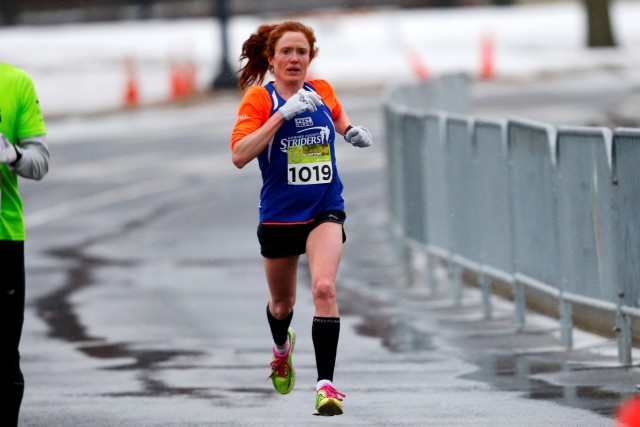
Limbo Relief for one runner
Our soon-to-be-released spring magazine notes that 10 local athletes will compete in the U.S. Olympic Marathon Trials. It also mentions that one runner’s entry was still in limbo.
Julia Roman-Duval, 33, of Columbia, Md., had run a personal best and trials-qualifying 2:40:55 at the California International Marathon — but as we went to press, she was still waiting to hear whether or not she would be allowed to compete.
Good news: Roman-Duval is in.
The backstory is that Roman-Duval, native to France and a permanent United States resident for five years, needed one of two things to happen to compete in the trials. She either had to gain citizenship before the race or the USATF had to be satisfied that her citizenship would be granted before the Olympics in August.
At this point it looks like Roman-Duval will have both scenarios working in her favor, though it was a long, tense ride to get there. She had applied for citizenship in July and, through her own homework, determined that the United States Citizenship and Services’ office in Baltimore would not process her application until March. Too late.
Next she turned to the USATF. But as of last week, no decision had been made, and Roman-Duval said that a USATF staff member had cautioned her not to get her hopes up. It was not likely she would be allowed to compete, she said she was told, unless her naturalization interview was scheduled before the trials.
“Hope started to fade at that point,” she said, “and I started to prepare myself for the idea that I would not be at the trials.”
Imagine training your heart out for a dream race that might not happen. On Saturday morning, Roman-Duval, physically able but mentally exhausted from all of the uncertainty, set out for her last long run still wondering if it was all for naught. That afternoon, though, she went to the mailbox one more time and found her answer. It was none other than a letter from U.S. Rep. Elijah Cummings (D-Md.) containing the good word that his staff had successfully expedited her naturalization interview.
The interview will happen this Friday, eight days before the trials. Thus, on Friday, Roman-Duval expects to both gain her citizenship and, at the very least, could present impending proof of citizenship to USATF. With that, early this week, Roman-Duval heard from USATF’s Jim Estes that she was in.
Roman-Duval has resided in the United States since 2006. She and her husband, who is a U.S. citizen, have three children, and as an astrophysicist, Roman-Duval is part of a team that contributes to the success of the Hubble Space Telescope. A triathlete who did not run in high school or college, she achieved solid marathon results off running just 12 miles a week. Based on that, her Howard County Striders teammates convinced her to gradually increase her mileage and intensity so she could take a shot at the trials standard.
“I still can’t believe it,” she said. “It has been such a long and hard struggle to make this dream come true before the deadline,” from trimming 20 minutes off her marathon personal best to finally gaining eligibility.
“My family” — including her husband, Miguel Roman — “is very excited and proud,” she said. When she told her youngest children, 3 and 4, about the news, they “listened, nodded, and moved on with their activities.” Her oldest, who is six, is anxious knowing she will be away from home for a few days, but has nonetheless been sharing the news at school.
Her Striders teammates are relieved too.
“Julia is a fantastic runner,” said masters runner Mick Slonaker. “She trained very smartly to get her trials qualifying time. We are very happy for her and proud of her.”
In 2000, McLean resident and fellow native of France Philipe Rolly was not as lucky. As a permanent resident, he was forced to sit out of that year’s trials and never ran the standard again.
But Roman-Duval will get her shot, and though she is not sure if another miracle is on the horizon, she is ready, for now, to relax and enjoy the taper. “I am also starting to think about the future,” she said, “and how this milestone will help me take my running to the next level.”
The Baltimore running scene will also be represented by Andy Weaver and former resident Christine Ramsey.
For running fans, the U.S. Olympic Marathon Trials are like a cult classic on a four-year loop. Every time the races are upon us, it feels as if we just saw the last ones yesterday. We again wonder: who will break through to the Olympics, who could surprise us, and who among our local running scene will be there.
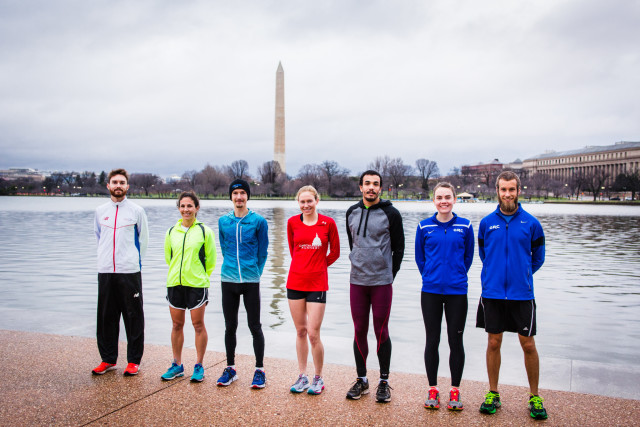
Meanwhile, outside the circle of hardcore running fans, there is some confusion about what the marathon trials even are. We saw this in 2003. Alexandria’s Heather Hanscom won the Marine Corps Marathon, her debut, fast enough to qualify for the trials and was interviewed by Andrea Koppell on CNN. Koppell asked if Hanscom’s goal had been to make the Olympic team; Hanscom explained she had only qualified for the trials; and Koppell ended the segment by wishing Hanscom luck … in the 2004 Olympics.
Follow the race
The race will be broadcast at 1 p.m. eastern on NBC and will stream on NBC Sports Live Extra, Saturday Feb. 13. You can download the app here.
The men’s race will begin at 1:06 and the women will start at 1:22.
RunWashington will be at the race posting updates about local athletes to Facebook and Twitter (@RunWashington) and Instagram (also@RunWashington)
So, what are the U.S. Olympic Marathon Trials, exactly?
The trials — first contested by men in 1968 and by women in 1984 – are both the inspiration and culmination of dreams. There is no qualifying race for the Olympics in which the door is open wider to amateur athletes. They just have to climb a mountain to go through it.
To qualify for the 2016 marathon trials in Los Angeles, men had to run a marathon faster than 2:19 or a half marathon faster than 1:05, while women had to go under either 2:45 or 1:15. (In December, both marathon standards were softened slightly — by a minute for men, two minutes for women — but they are still tougher than they have been historically.)
For D.C. runner Jim Hage, the marathon trials was a force that pushed him to go all in. Before his second trials, in 1992, he quit his job to train full time and went on to finish inside the top 10. His eighth place finish in fact matched his prediction for himself in a prerace trials pool with friends — “but that was based on a best-case scenario,” he says, “and I was ecstatic with the finish.”
For Landover legend Darrell General, the trials fueled consistency. He is among a rare few to run in five trials.
And for Hanscom, a physician assistant in Arlington, the trials was an opportunity to put her best fitness on the line and see where it would take her. Coached by Matt Centrowitz, the 2004 race was only her second marathon, and she knew it would be much dfferent than her first, which she won by more than 20 minutes.
As she steeled herself for the next challenge of going toe to toe with the nation’s best, Hanscom’s mantra became: “to be able to walk away from a race, or any experience, and know that I did my best.” She remembers seeing her family members and friends who traveled to St. Louis to support her. She remembers feeling the whole time like she would “implode” and the way everything hurt, especially her blistering feet. And as she crossed the line, and as her sixth place, 2:31:53 performance — a seven-minute personal best — came into focus, Hanscom could see that “anything was possible” and, almost immediately, started looking towards the future.
The marathon trials, seen from a national perspective, trace the history of modern road racing: boom after boom after boom. And as we head into the 2016 trials, in Los Angeles, and look at this from a local perspective, we can see our own boom: our running scene has never had more representation.
By our count, ten athletes residing in either D.C. or Northern Virginia will be on the starting line Feb. 13. In the Baltimore area, Andy Weaver has qualified, too.
Here are some of the storylines we’re following.
The contenders
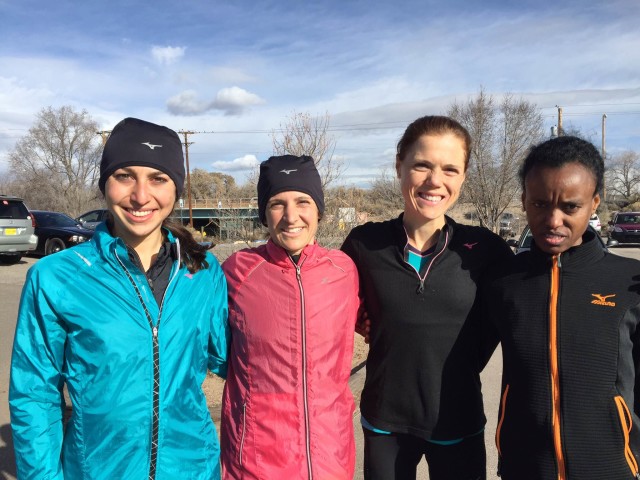
In the women’s race, Shalane Flanagan is the clear favorite. But take note, we have our own Flanagan to cheer for: Lindsay, an Illinois native and recent University of Washington graduate. She moved to Silver Spring last year to join a Mizuno-sponsored training group with Maegan Krifchin and Serena Burla.
Flanagan’s 2:33:12 debut in Houston seeds her at 19th heading into the trials, but her second marathon, though slower, was even more impressive. At last summer’s Pan American Games in Toronto, Flanagan went out with the lead pack and persisted through humid, brutal conditions to earn a bronze medal in 2:36:30. An American woman had not medaled in the event in 20 years.
As of December, when we reached out to their coach, Flanagan and her training partners were out in Albuquerque, New Mexico. In a RunWashington story last fall, though, Flanagan talked about their routine when training in Silver Spring. The trio would meet for workouts at 7 a.m. and in the late afternoon, with Burla commuting in from her home in Stafford.
At the last trials in Houston, Burla, now 33, was in the mix at the front of the pack, but collapsed at 18 miles due to hypoglycemia. Burla, however, had already conquered tougher setbacks. In 2010, for instance, after finishing second at the USA Half Marathon Championships, she scheduled some tests to figure out why her hamstring was hurting. Turns out, the pain had been stemming from a malignant soft-tissue tumor that required a radical surgery. Her surgeon was concerned that Burla would never run again.
Burla not only ran again – she qualified for the marathon trials, and after dropping out, came back in her next marathon to chop her personal best down to 2:28:27. She has since chiseled her personal best down to 2:28:01, giving her the 5th seed heading into Los Angeles. In 2014, she triumphed at the USA Half Marathon Championships. And last year, a month after Flanagan’s result in Toronto, Burla finished 10th in the marathon at the world championships in Beijing.
Krifchin, too, could factor in the race to make an Olympic team. The New York native and Syracuse graduate’s marathon debut of 2:33, run last year at the Hamburg Marathon, seeds her two spots behind Lindsay Flanagan. In October, though, Krifchin, a part-time occupational therapist, also won the Rock ‘n’ Roll Philadelphia Half Marathon in 1:09:50, giving her a faster half marathon than Burla. Even professionals often approach their debut marathon more conservatively to gain experience, and Krifchin’s was described as a controlled effort (she ran even splits). What’s in store, then, for the 27-year-old’s second attempt at the distance in Los Angeles?
The dreamers
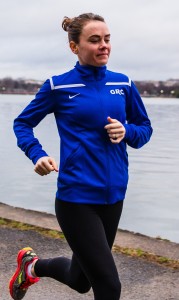
Eight years ago, at the women’s marathon trials in Boston, Teal Burrell and her sister hatched an experiment while they were watching from the sidelines. How long, they wondered, could they keep up with America’s best? When one pack came along, they took off sprinting, and just as quickly fell behind.
Some time before this, Burrell had run a marathon in 4:07 and checked the goal off her list of things to accomplish. For a few years, that was enough. But that day in Boston, Burrell was in the early stages of plotting a comeback. She recalled this memory in 2012 in launching her blog, “Miles to the Trials,” to chronicle her seemingly improbable goal to reach the marathon standard. By then, Burrell had gone from being a recreational runner to sub-3, but she was still a long way from running under 2:45.
Burrell signed off the post, as she typically does, by saying “Dream Big” – and that is exactly what she did, even at times when those dreams seemed unrealistic. Like in 2014 at the California International Marathon, when she lined up with the goal of dipping under the then-trials standards of 2:43. Had Burrell put her recent half marathon best, 1:19:28, into a race predictor calculator, the computation would have read: don’t even think about it. Instead, after running 16 miles at goal pace in practice, she pressed forward, and believed, and crossed the line in 2:42:13.
Now that moon-shot race is here, and Burrell, who is coming off a half marathon PR that still not does compute to sub 2:43, has yet again attached herself to what she describes as another unrealistic goal. Like usual, the pure marathoner is operating on a combination of confidence and fear.
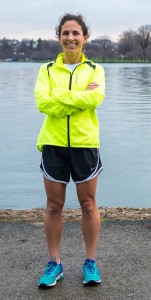
“I’d say I’m more confident in my abilities since CIM, but I certainly still have many, many moments of self doubt. I think that’s the same it’s been in my entire progression as a runner — with every new PR I think I can keep getting faster … but I also have days when my new goals seem crazy, and it’s hard to believe I ever ran 2:42.”
Meanwhile, one of Burrell’s teammates on the Pacers Running//GRC New Balance team, Emily Potter, of Alexandria, has qualified for her third trials, but this was one was perhaps the least probable.
The 36-year-old had the will to train and get in races to advance her preparation. But Potter also had more on her plate – namely, raising two young daughters, Evelyn, 3, and Adelaide, 1. Potter, frankly, was not sure if she could find the time to train like she has in the past, and she hasn’t trained the same way. To make it work, Potter has been bringing Evelyn and Adelaide along for the ride, logging the vast majority of her miles while pushing them in a jogging stroller
In August, with qualifying time running out, Potter headed up to the Edmonton Marathon and covered the course in 2:42:56, just under the standard yet 18 minutes ahead of second place. She set a course record, too.
Since qualifying for the trials, Potter has been trying to make sure she at least gets to run solo for a weekly workout and long run. Otherwise, not much has changed.
“Training wise, I’m just trying to fit in as much running as my kids will tolerate. So it’s less mileage and quality work than I did before previous trials, and practically zero recovery time, but that’s life as a mom.”
The debutants
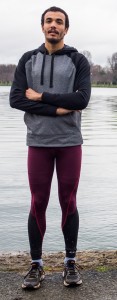
As the Jan. 17 qualifying deadline for the trials approached, runners needing the standard flocked to fast half marathons, including the Philadelphia Rock ‘n’ Roll Marathon on Halloween. For those who succeeded, oftentimes the next question became: “Do I really want to run my first marathon at the trials?” Carlos Jamieson, who qualified in Philadelphia, and Chris Kwiatkowski, who notched his second sub-1:05 half marathon there, decided the timing was right.
In Philadelphia, Jamieson, 28, a physical education teacher in D.C., qualified by running a three-minute personal best, 1:04:27. The American University graduate had been making a gradual shift up to longer distances, starting with a win at the D.C. Rock ‘n’ Roll Half Marathon in March, while he was training for track races. Last spring, he ran 13:50 for 5,000 meters, a personal best.
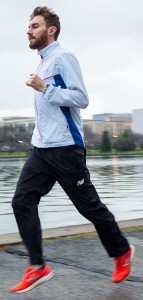
After track season, Jamieson upped his mileage and lengthened his intervals to gain the strength he needed for longer races. But even after qualifying, Jamieson says he had his doubts about whether it was wise to make his marathon debut in such a high stakes, competitive race.
To gain clarity the self-coached Jamieson consulted with his “advisors.” College teammate Dustin Emrani, a half-miler and member of Israel’s Olympic team, told him: if he was going to do it, make it count. Colin Eustis, who has the school record in the indoor 5,000, urged him to take advantage of what could be a once-in-a-lifetime opportunity. So Jamieson again increased his mileage— he’s up as high as 105 miles per week, all in single runs. He says his goal is “to compete to the best of my ability” and meet what he describes as an “ambitious goal.”
Kwiatkowski, an American University assistant coach, competed for the University of Oregon but was limited by a series of injuries. Since settling in Arlington, though, Kwiatkowski has established himself as the top runner in the area, most notably with his fourth place, 48:17 finish at the Army Ten- Miler in 2013. Kwiatkowski says his decision to make the leap up in distance came down to wanting to take advantage of a great opportunity. “I had a small debate about whether to run or not, but I decided pretty quickly to compete. You only get the opportunity every four years, and I felt like it would be a shame not to compete.”
Over the holidays, Kwiatkowski, coached by Matt Centrowitz, returned to his hometown in Bellingham, Wash., maintaining weekly mileage north of 100 miles. “I’ve been feeling good. … I am definitely a little scared of the marathon distance, but I have been approaching it the same as any race: preparing the best I can to get to the starting line healthy and excited to compete,” he says.
The rising star
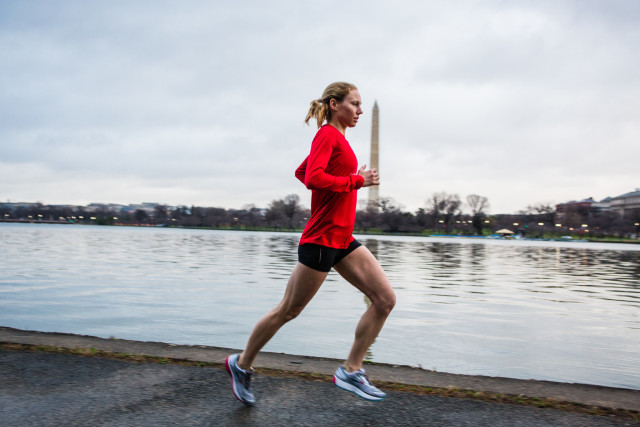
You may recognize me
Some runners with local connections will racing in L.A.
Sara Bard
former Leesburg resident and
Capital Area Runners member
Anna Corrigan
Lake Braddock High School
Ricky Flynn
Damascus High School
Everett Hackett
George Mason University
Mark Leininger
American University
Matt Llano
Broadneck High School
Christine Ramsey
former Baltimore resident who raced here often
Julia Roman-Duval
Columbia resident with an interesting story
Katie Sheedy
former D.C. resident and Capital Area Runners member
Andy Weaver
Baltimore resident who won the 2015 Parks Half Marathon
Hiruni Wijayaratne
Herndon High School
Like Kwiatkowski, Susanna Sullivan was a strong prep runner whose progress in college was slowed by injuries. Sullivan, of Falls Church, ran at George Mason High School and continued at Notre Dame, but has seen her best success on the local roads and at major races around the country. She trains with Capital Area Runners.
Sullivan’s stock shot up in 2014 with a fourth place finish in the national 10 mile championships (none other than the Cherry Blossom Ten Mile Run) and a nation-leading 26:51 at the St. Patrick’s Day 8k. A month out from the trials, Sullivan, not yet in taper mode, lowered her half marathon personal best to 1:12:56.
The ride hasn’t always been smooth. Sullivan, roughly a year ago, did experience some of her first injuries since college. But the 25-year-old school teacher bided her time, completing tough pool workouts and shifting her marathon debut to last year’s Grandma’s Marathon in June.
Her goal was to achieve the trials “A” standard time of sub-2:37, for which athletes get their race expenses covered, and Sullivan says she was surprised by how controlled the pace felt in running 2:35:37. “I was hesitant to make any moves or press too much because I was just focused on finishing. I wanted to get to the finish line with something still in the tank so that I could be excited to really race my next marathon.”
The hard training
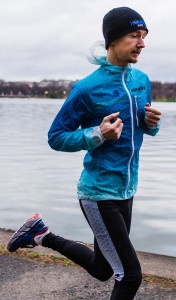
Our trials qualifiers did not get a respite from training during the holiday season. Instead of happy hours and cookies and leisurely mornings, they turned to grueling workouts and two-a-days.
On Christmas morning, Tyler Andrews woke up early and set forth on one of his staple marathon workouts: a continuous effort covering the full marathon distance. He did seven 5k reps at goal marathon pace separated by 1k intervals at a more moderate pace (around 6:00 per mile). The total workout gave the 25-year-old Alexandria resident a full marathon in 2:18, only two minutes slower than his personal best.
There must be a thread on some running message board devoted to the pitfalls of such workouts. But for Andrews, it is clear that workouts like these, and 160-mile training weeks, have led to a transformation: the Tufts graduate, who was never a Division III All-American, is now a 2:16 marathoner poised to go further in the trials.
“It’s all relative, and it has never been about big jumps [in training], just finding what works for me and focusing on increasing that specific stimulus from season to season and year to year,” says Andrews, who is sponsored by Hoka One One and works for Strive Trips, which organizes student service trips. On one hand, Andrews represents a sea change in marathon training, a new generation of marathoners inspired by new, more intense, more hyper-specific training methods espoused by coaches like Renato Canova.
But perhaps it’s simpler than that. Perhaps it goes back to the dream. Consider Kieran O’Connor, who probably doesn’t know who Canova is.
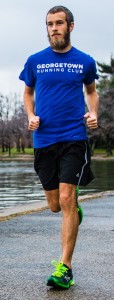
A couple summers ago, he showed up to a Pacers Running//GRC New Balance practice having dabbled in running in high school and having skipped collegiate competition. He had picked running back up after college and, unbelievably, was the 8th American at the brutally hot 2012 Boston Marathon. Except O’Connor had then spent a brutally hot year in Egypt, for graduate school. And there he was, new in town, doing a track workout in basketball shorts and training shoes.
It soon became clear that O’Connor only had one pair of real running shorts. Prior to joining the club, he raced shirtless. At the Leesburg 20k, he had to be shown how to look up his race bib number and then got caught in the bathroom line. His teammates still do call him “the rube.”
But with each race, and each workout, O’Connor crept closer and closer to where he was before Egypt. Then he surpassed that level, and surpassed more levels. After lowering his marathon personal best to 2:20 at Grandma’s in June, O’Connor finished a bit behind Jamieson in Philadelphia to punch his ticket to the trials. One Saturday morning at the track recently, O’Connor set out on a 10-mile tempo with the goal of going under 50 minutes, his teammates flowing in out and out — two laps, three laps, a mile, as far as they could go. O’Connor was rolling.
And it was all part of the plan. “Even when I was a 2:30 marathoner, I was pretty sure that I could get to the trials, which, I don’t now, maybe that’s crazy,” he says. “Now that I’ve reached this level, I have the same certainty that … I can do more and get better.”
With O’Connor, and all of our qualifiers, at the trials, the bar will be set even higher. And when the gun goes off, the dream chasing will continue.
Limbo Relief for one runner
Our soon-to-be-released spring magazine notes that 10 local athletes will compete in the U.S. Olympic Marathon Trials. It also mentions that one runner’s entry was still in limbo.
Julia Roman-Duval, 33, of Columbia, Md., had run a personal best and trials-qualifying 2:40:55 at the California International Marathon — but as we went to press, she was still waiting to hear whether or not she would be allowed to compete.
Good news: Roman-Duval is in.

The backstory is that Roman-Duval, native to France and a permanent United States resident for five years, needed one of two things to happen to compete in the trials. She either had to gain citizenship before the race or the USATF had to be satisfied that her citizenship would be granted before the Olympics in August.
At this point it looks like Roman-Duval will have both scenarios working in her favor, though it was a long, tense ride to get there. She had applied for citizenship in July and, through her own homework, determined that the United States Citizenship and Services’ office in Baltimore would not process her application until March. Too late.
Next she turned to the USATF. But as of last week, no decision had been made, and Roman-Duval said that a USATF staff member had cautioned her not to get her hopes up. It was not likely she would be allowed to compete, she said she was told, unless her naturalization interview was scheduled before the trials.
“Hope started to fade at that point,” she said, “and I started to prepare myself for the idea that I would not be at the trials.”
Imagine training your heart out for a dream race that might not happen. On Saturday morning, Roman-Duval, physically able but mentally exhausted from all of the uncertainty, set out for her last long run still wondering if it was all for naught. That afternoon, though, she went to the mailbox one more time and found her answer. It was none other than a letter from U.S. Rep. Elijah Cummings (D-Md.) containing the good word that his staff had successfully expedited her naturalization interview.
The interview will happen this Friday, eight days before the trials. Thus, on Friday, Roman-Duval expects to both gain her citizenship and, at the very least, could present impending proof of citizenship to USATF. With that, early this week, Roman-Duval heard from USATF’s Jim Estes that she was in.
Roman-Duval has resided in the United States since 2006. She and her husband, who is a U.S. citizen, have three children, and as an astrophysicist, Roman-Duval is part of a team that contributes to the success of the Hubble Space Telescope. A triathlete who did not run in high school or college, she achieved solid marathon results off running just 12 miles a week. Based on that, her Howard County Striders teammates convinced her to gradually increase her mileage and intensity so she could take a shot at the trials standard.
“I still can’t believe it,” she said. “It has been such a long and hard struggle to make this dream come true before the deadline,” from trimming 20 minutes off her marathon personal best to finally gaining eligibility.
“My family” — including her husband, Miguel Roman — “is very excited and proud,” she said. When she told her youngest children, 3 and 4, about the news, they “listened, nodded, and moved on with their activities.” Her oldest, who is six, is anxious knowing she will be away from home for a few days, but has nonetheless been sharing the news at school.
Her Striders teammates are relieved too.
“Julia is a fantastic runner,” said masters runner Mick Slonaker. “She trained very smartly to get her trials qualifying time. We are very happy for her and proud of her.”
In 2000, McLean resident and fellow native of France Philipe Rolly was not as lucky. As a permanent resident, he was forced to sit out of that year’s trials and never ran the standard again.
But Roman-Duval will get her shot, and though she is not sure if another miracle is on the horizon, she is ready, for now, to relax and enjoy the taper. “I am also starting to think about the future,” she said, “and how this milestone will help me take my running to the next level.”
This story appears in the Spring 2016 issue of RunWashington.
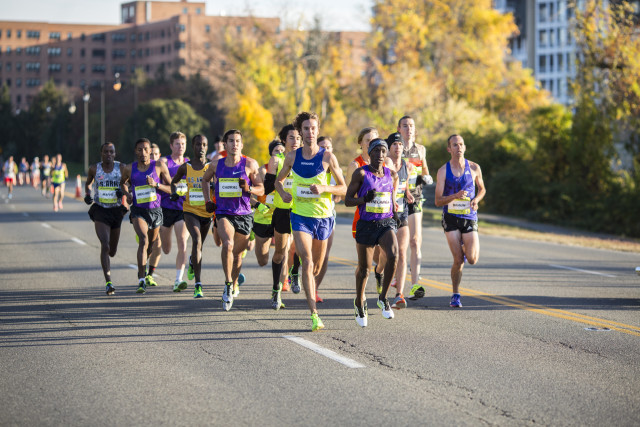
It looked like Sam Chelanga was ready to press the pace. The lead pack – more like the entire elite field – was approaching the two-mile mark, stretching across George Washington Memorial Parkway, when the 30-year-old moved out front and took control of the national 12k championship this morning.
Turns out it was just a test, or more like a suggestion. “I was just trying to instigate the guys to go faster but they didn’t want to do it,” said Chelanga. So he slowed down, the pack again enveloped him, and Chelanga steeled himself for the final three-quarter-mile long straight shot to the finish.
Even then there were still at least 10 potential winners. But as one kick led to another kick, and as that kick led to a sprint, Chelanga finally found himself out front for good, able to hold off Tyler Pennel by a fraction of a second to win his second national road title in 34:35, a pace of 4:39 per mile for more than 7 miles.
“At some point the last stretch I felt like maybe Tyler’s got it more than me,” said Chelanga, “but then I’ve been there before and I just know be patient, be patient.”
The Kenya native and recent U.S. citizen had in fact been there as recently as last month, when he outsprinted Pennel to win the 10-mile championships in Minneapolis.
“It is always good to go home knowing you ran through the line, you gave it your all,” said Chelanga.
[button-red url=”http://www.areep.com/events/usatf12k/2015/” target=”_self” position=”left”] Results [/button-red]This was the .US National 12k championships’ third running since USATF and Neustar partnered to launch this event in Alexandria. Previous renditions have pitted runners peaking specifically for the race with runners still recovering from fall marathons. But with the marathon trials ahead, fall marathons were skipped. Meanwhile, most members of the field were united in seeing the road ahead of them as part of the longer road to trying to make an Olympic team. The marathon trials are in February in Los Angeles, while the track trials will be held in July in Eugene.
“I would have liked to win. That’s why I’m out here,” said Pennel. The Blowing Rock, N.C.-based runner added, however, that today’s race was the latest indicator that he is entering the buildup to the marathon trials in a good place – mentally, physically, and developmentally.
“You run for third, you can get fourth. If you run for the win and get third, you still make the team,” he said, describing what will be his approach to the trials.
Defending champion Brian Shrader, of Flagstaff, Ariz., figured the marathon focus was part of what kept the early pace slower than in the first two runnings of the 12k. The leaders went through the opening mile in the low 4:50s, as opposed to 4:40 in previous years.
[Best_Wordpress_Gallery id=”3″ gal_title=”.US National 12k 2015″]
Shrader’s own shift at the front, which came after the turnaround of the out-and-back course, was inspired by seeing the now-three-time 12k winner Molly Huddle opening up a huge lead. “She has a 50-meter lead already. It’s like, we need to start actually racing. … So I tried to throw in some surges to make it more of a race,” he said.
Shrader’s efforts did lower the pace closer to 4:30-per-mile for much of the second half of the race, yet a big lead pack remained intact.
“It was comfortable the whole time,” said Shadrock Kipchirchi, who finished third in just his second road race in 34:37. But this race came down to the final minute. And when push came to shove, the U.S. Army World Class Athlete Program member discovered, like others, that he “didn’t have that gear” to break the tape.
Jim Spisak, who was fourth in an identical time to Kipchirchi, came to the same conclusion. Spisak trains in Rhode Island as a member of the nonprofit New England Distance Project, which supports elite athletes in exchange for them contributing to community programs (he provides tutoring in math to middle and elementary school students), and is coached by Kurt Benninger, husband of 12k champion Molly Huddle. “With about a half mile I tried to move but just couldn’t go with them,” said Spisak, referring to Chelanga and Pennel.
Shrader came through in fifth, two seconds behind Spisak. Since winning here last year Shrader has not created headlines, so to speak, but he did set personal bests at 5k and 10k, qualified for his first national championship (something he never did in high school or college), and has his sights set on the track trials. Shrader’s training partner, Diego Estrada, national half marathon champion, was seventh in 34:46, and, like Chelanga, is preparing to make his marathon debut at the trials.
Then there was Aaron Braun, of Alamosa, Colo., who won his first national title here in 2013. Last year, in trying to defend his title, he led the whole race until the final quarter mile. “This year my plan was basically to do the exact opposite,” he said. And true to form, Braun could often be seen flanking the lead back, in a way running his own race.
“I am disappointed with how today went specifically, but in the big scheme of things I know that I am where I should or need to be for the [marathon] trials,” he said. “I just need to be becoming really efficient at that 4:50-, 5-minute pace.”
Braun expressed appreciation for this still relatively new event. Neustar and USATF are at the end of their three-year agreement, and Braun said he hopes the 12k will continue.
“It’s been great for me,” Braun said. “It’s been great for a lot of guys who weren’t superstars.”
It was great, for sure, for Jared Ward, who won the national marathon championships in March and finished sixth today to win the 2015 USATF Running Circuit, in which American runners earn points by competing in various national championships.
“Today was about one more opportunity to have a good race and learn something about me and learn something about the other guys I’ll be competing against in the [marathon] trials,” Ward said.
Asked what he learned about his competitors, Ward said:
“You watch a guy like [Chelanga] out there and he takes his turn leading to keep the pace honest, but as you saw at the end he’s also a speed runner. But you look at [Pennel] as well. I’ve always looked at [him] as a strength runner; he’s tough on the hills, but he’s got some wheels when we get into these rhythm races too. I keep seeing stuff that indicates we have a lot of serious guys vying for a championship, so it gives me motivation to go home and say, it’s time to get some work in.”
D.C. area runners were keeping pace with the nation’s best today and will seek to do the same come February. Though he was not listed as an elite athlete, Chris Kwiatkowski, of Washington, D.C., was in the thick of the lead pack until 10k.
Tyler Andrews of Arlington was 18th in 36:39.
Andrews said he was coming out of a big block of training. And before he starts focusing specifically on the marathon trials, he has one more race to tackle: none other than the world 50k championship, in less than three weeks.
The race also played host to the national masters championship, won by 49-year-old Kristian Blaich in 39:29. McLean’s Philippe Rolly finished second, leading the Baltimore Washington Athletic Club to the 40+ title. Playmakers Elite/New Balance won the 50+ team title, the Boulder Road Runners won the 60+ title, and the Shore Athletic Club won 70+.
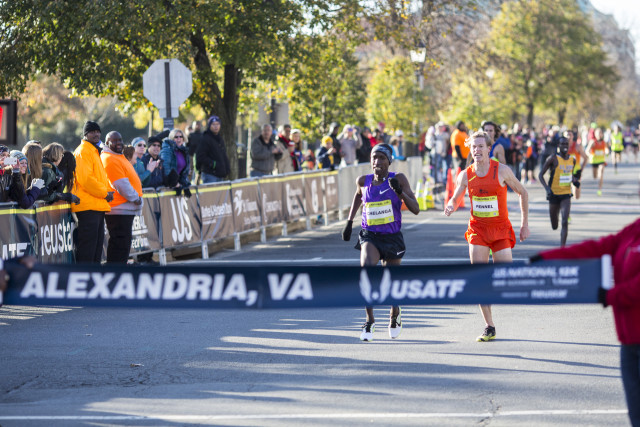
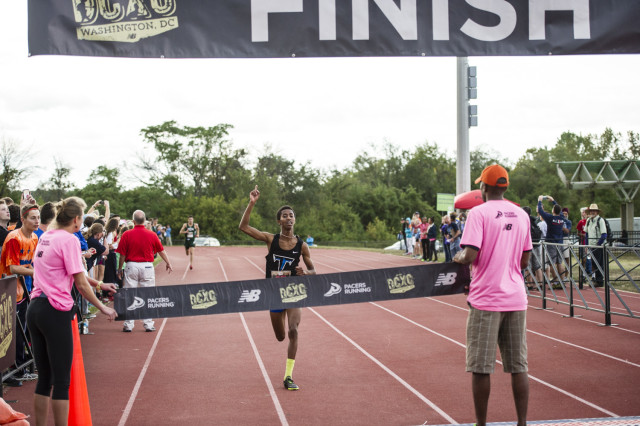
Forty-one schools and more than 3,000 high school cross country runners flocked to Kenilworth Park in Northeast D.C. Saturday for the second DCXC Invitational. The invitational was for the most part a D.C., Maryland, Virginia showdown, but the meet also featured appearances from Thousand Islands Secondary School, from Ontario, Canada, and Trinity High School, from Louisville, Kent.
The format was like last year. The varsity races were split among classes and each race scored just three runners per team. A new college race allowed American, George Washington, Howard and Catholic universities to race in the district.
[button-red url=”http://dcxc15.s3-website-us-east-1.amazonaws.com/#/” target=”_self” position=”left”] Results [/button-red]The results compiled for all races led to James Madison winning the girls’ overall team title and Trinity – 18-time Kentucky state champions – winning the boys’ races. James Madison, which also won the aggregate overall title, was followed by Walt Whitman, Walter Johnson, W.T. Woodson and Yorktown. Trinity was followed by Wootton, Gonzaga, Thomas Jefferson, and James Madison.
Trinity did more than up the level of competition. The all-boys Catholic school added Irishness plus some great soundbites.
Example: As Trinity’s Trevor Warren, who won the sophomore race, wrapped up a Pace the Nation podcast interview with Chris Farley, one of Warren’s teammates called out: “Trevor, you didn’t announce the mixtape, bro.”
Trinity’s coach, Greg Waggoner, said that D.C.’s Edmund Burke School had made the trip out to Louisville for Trinity’s invitational. He heard about the DCXC Invitational from Edmund Burke’s coach, Brian Bobo, and spent Friday with 40 of his runners “doing the D.C. tourist thing.”
Walking through the DCXC Invitational felt like walking through a festival. The fields were covered with tents; inside the track DJ Thunderbunny took requests. Parents, fans, and teammates massed in several places to provide support: the one-mile mark, the portion looping behind the starting line, and particularly the final stretch on the track.
[button-red url=”http://www.runwashington.com/2014/09/28/dcxcinvite/” target=”_self” position=”left”] Last year[/button-red]T.C. Williams’ Sam Schneider enjoyed the atmosphere. He could hear his family and friends calling out his name as he entered the last 50 meters on the track, which helped him enough to pick up two spots to crack the top 100 in the junior boys race. He was 99th in 19:17. “It’s great,” he said. “It really helps you run through the course. It’s a lot easier with people chanting your name.”
The course itself was flat, run on an open, windswept field marked with pink flags and ribbons and neon cones. The feared rain never came and the temperature was decidedly cool (last year temps hovered above 90 degrees). Wind, however, was the day’s big factor. Had the freshman girls turned around just before the gun fired, after one false start, a little past 3 p.m., they might have seen one team’s tent go temporarily airborne.
Freshman girls
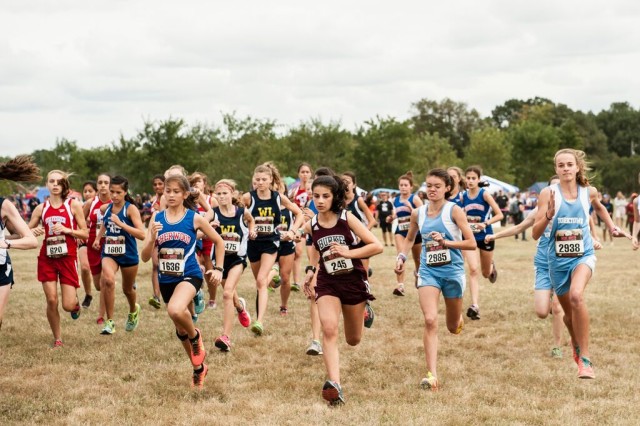
One athlete in the freshmen girls race who was not fazed by the headwinds at all was Tuscarora’s Ava Hassebrock, who won the race in 19:58. “When you are running, the wind is really nice because it cools you off,” she said.
The soft-spoken Hasselbrock said she expected to be in the top five but not necessarily gunning for the win. Early in the race, she and Poolesville’s Nandini Satsangi, second in 20:12, separated themselves from the pack.
“It was a lot of fun,” said Satsangi. “I love chasing and being able to latch on to somebody.”
[button-red url=”https://www.facebook.com/media/set/?set=a.1205115692848994.1073741866.189448104415763&type=1&l=d7542886c3″ target=”_self” position=”left”] Photos [/button-red]For Satsangi, the DCXC Invitational offered a challenge she had yet to encounter in her first season: not racing in the morning. Most freshmen would perhaps be thinking about how to time their nutrition differently. But Satsangi, who has epilepsy, had to think about when to take her medication. “It made it difficult to control my pace,” she said with a big smile, still absorbing her performance.
Georgetown Visitation’s Ally McKenzie, running only her second 5k, was third in 20:36. “I knew there were going to be some really good freshmen coming into this, so I just wanted to go out there and try my best.”
Her best effort helped Georgetown Visitation win the team title, as McKenzie’s classmate, Brennan Dunne, came through in 10th in 21:29. Washington-Lee, in second, edged out Briar Woods by just a point.
Freshman Boys
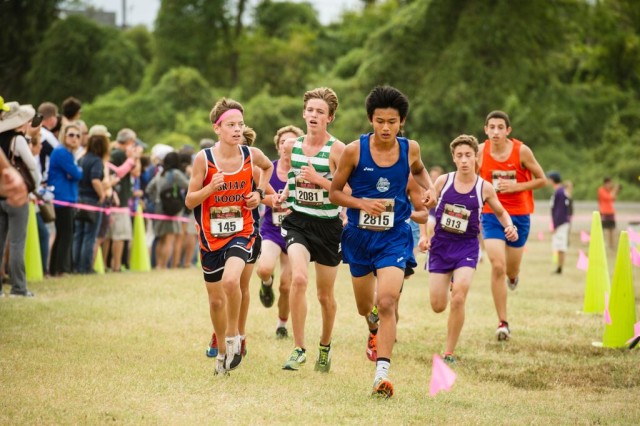
When they hit the track, Freedom’s Connor Wells seemed to have an insurmountable lead. Until he didn’t.
As Wells rounded the final turn, Washington-Lee’s Jonny Jackson pulled up right next to him. So did Trinity’s Jack Baum. Shocked, Wells kicked. “I got really nervous,” he said, “and I just poured it all out.”
Wells held off Jackson, in second, and Baum, in third, though they all finished in the identical times of 17:07.
Jackson and Baum had at least one thing in common. They weren’t pumped up just to be on the podium.
Jackson: “It’s better than I thought I would do, but I really would have liked to win.”
Baum: “I was pushing pretty hard at the end. I thought I could get him, but my legs just didn’t have anything left.”
Watch out Kentucky harriers!
[button-red url=”https://www.facebook.com/media/set/?set=a.1205113746182522.1073741865.189448104415763&type=1&l=14d985234b” target=”_self” position=”left”] Photos [/button-red]Trinity won the freshman team title with just 15 points, putting seven boys in the top 20, with a spread of 17:07 to 18:44. Nick Neumann was fifth in 17:52, Nick Stauble seventh in 18:02.
Stauble noted, “We have high expectations,” to which Shane Williams, who was 10th in 18:19, added that their long-term goal is “nationals.”
Waggoner, in his 14th season, was pleased by their performances.
“They are a great little group of guys,” he said, “and one of the nice things is they like working with each other.”
Trinity was followed by Freedom and Thomas S. Wootton in the freshman boys team standings.
Sophomore Girls
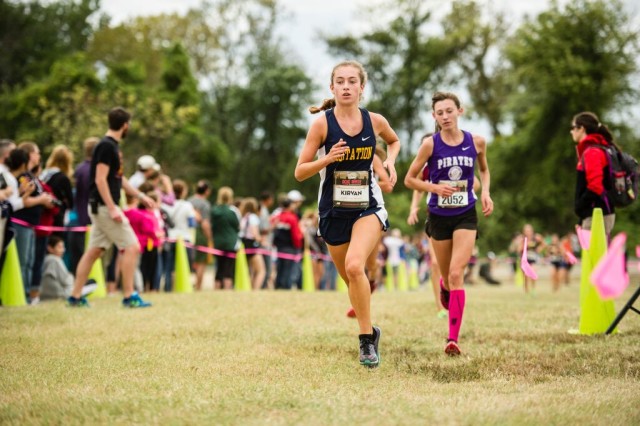
George C. Marshall’s Heather Holt, coached by the legendary Darrell General, had a pretty simple race strategy: “to get out fast.” She also has pretty simple goal for the rest of the season: “to keep running faster.”
Holt passed through the mile in 5:28, 16 seconds up on the field, and pushed further ahead to earn a decisive victory in 18:18 and help George C. Marshall win the team title. It was the fastest girls’ time of the day.
Tuscarora’s Emma Wolcott, second in 18:47, said she mostly had to run her own race but appreciated having Holt to chase. “I think if I had been in front it would have been a little slower.”
[button-red url=”https://www.facebook.com/media/set/?set=a.1205121159515114.1073741867.189448104415763&type=1&l=12576773b0″ target=”_self” position=”left”] Photos [/button-red]Wolcott was in turn a decisive runner-up. Walter Johnson’s Abigail Green rounded out the top three in 19:25. In the team standings her squad was right behind second-place James Madison, led by Jeana Bogdon‘s fourth place showing in 19:45.
For meet director Desmond Dunham, the race inspired some double duty. The Wilson coach was pleased with the performance of his sophomore girls. Alex Hannah led Wilson, finishing 20th in 21:15.
“I’m in a position to give a lot of coaches a much better experience,” said Dunham, who has coached in the area for decades, of meet directing. “With that I am blessed to be able to be in that position. But I don’t like stepping away from my coaching hat too much.”
Dunham gave his Wilson girls high-fives and congratulated them on a 7th place. He then exited the finish area and went back to his other job, saying, “Alright. I’m happy now.”
Sophomore Boys
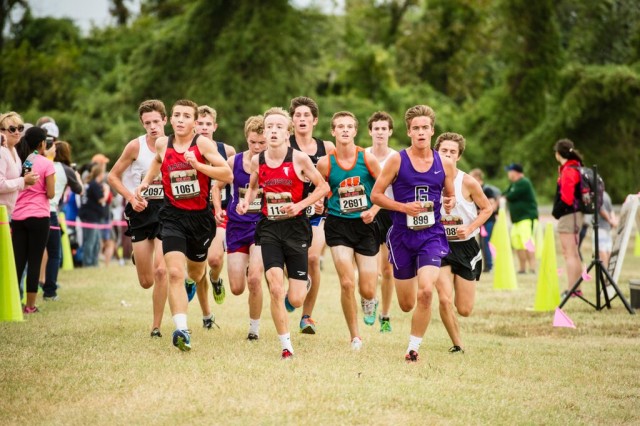
Rest in peace Yogi Berra. This one really did seem like déjà vu all over again.
[button-red url=”https://www.facebook.com/media/set/?set=a.1205122502848313.1073741868.189448104415763&type=1&l=5010c50dd9″ target=”_self” position=”left”] Photos [/button-red]The sophomore boys race went out conservatively. A big pack went through the mile in 5:15. This was followed by a big slowdown – a second mile covered in roughly 5:40 – that kept around 10 boys in the hunt for the win.
Warren, of Trinity, said: “I didn’t want to get out too hard. I just stayed with the pack, and then with about a mile to go we started pushing it.
It was all over. Warren had the victory all wrapped up. But then Tuscarora’s Derek Johnson pulled up next to him.
Warren said he no idea Johnson was so close. “But then he passed me,” he said, “so I had to get around him so I could beat him. I usually have a pretty good kick so I knew I could do it.”
Johnson finished in the identical time of 16:51. “I thought I had him,” Johnson said. “I thought [Warren] kicked too early, but I guess he had more than I thought.”
Thomas Jefferson’s Dylan Klapper took third, finishing just two seconds back in a 10-second personal best. “I was happy,” he said, “because I was able to stay with the pack for most of the race, then I kicked strong at the end.”
Trinity also won the sophomore title. Gonzaga was second, led by John Colucci, last year’s freshman winner, in seventh in 17:11. Tuscarora was third.
Junior boys and girls
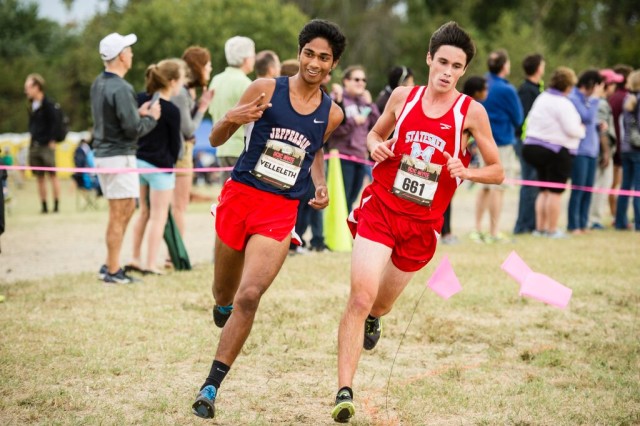
As dusk crept closer there was almost a chill in the air. The wind held steady as more jubilant harriers, done with their races, ran back and forth – field to track, track to field – cheering on their teammates.
This year Thomas Jefferson’s Saurav Velleleth was on the starting line. Last year he won a Varsity B race, in the morning, so he could go to Homecoming.
[button-red url=”https://www.facebook.com/media/set/?set=a.1205126889514541.1073741870.189448104415763&type=1&l=56007a46ac” target=”_self” position=”left”] Photos [/button-red]Perhaps describing why times, despite cooler temps, were a bit slower than last year, Velleleth said the second loop in the field was against the wind “and that kind of threw me off.” It didn’t throw him off much, though: Velleleth won in 16:16, becoming the day’s first varsity boy to win a race easily.
Runner-up was another matter. Velleleth left George C. Marshall’s Patrick Lynch in what Lynch described as no-man’s land and ultimately a tight race for second. Lynch held off third place Jackson Betts, of W.T. Woodson, by just a second. Jackson was just a second ahead of James Madison’s Sean Grimm, who was just two seconds in front of Gonzaga’s Harry Monroe.
Velleleth said he “knew it was going to be a fun race.” And he riled up teammates and Thomas Jefferson parents when, talking to Farley, he mentioned what Klapper had said after the sophomore race: “We want to win states,” Velleleth said.
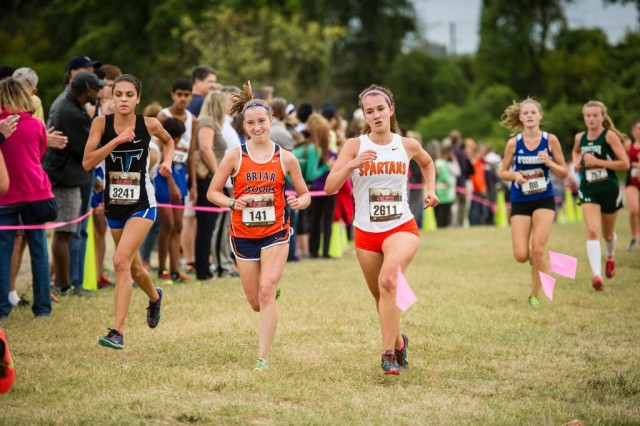
In the junior girls division, James Madison’s Devon Williams won in 18:49.
[button-red url=”https://www.facebook.com/media/set/?set=a.1205123919514838.1073741869.189448104415763&type=1&l=3825fab401″ target=”_self” position=”left”] Photos [/button-red]On one hand, it was a slower time than Holt and Wolcott had run in the sophomore race. On the other, Williams’ win was even more dominating. She won by 46 seconds, finishing before the next runner, Winston Churchill’s Julia Reicin, had even entered the track.
Winning – more than time – seems to be Williams’ priority. Asked if 18:49 was fast for her, she said, “Kind of?” Asked what her 5k personal best is, Williams added, “I’m not sure.”
Reicin was proud of her own effort. She ran her own race, she said, starting slowly and patiently moving up to second, the way she likes to run.
Williams’ victory, meantime, catapulted James Madison to the junior team title. Olivia Woods, third in 19:46, helped Walt Whitman finish second ahead of Thomas Jefferson.
Senior girls
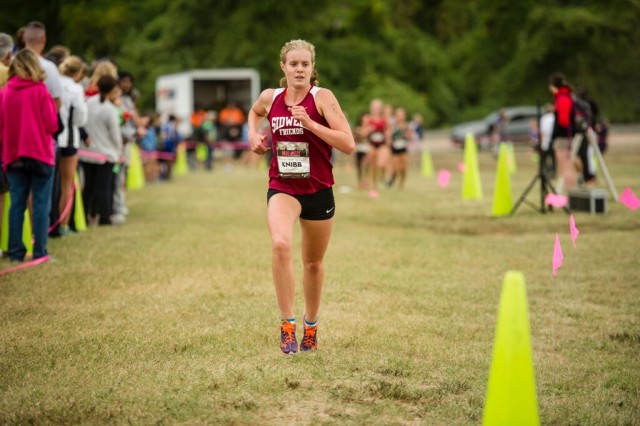
Westfield’s Sara Freix had run hard. She had to sit for a while, looking woozy, before she could talk to a reporter. While she caught her breath, James Madison’s Morgan Wittrock, who edged Freix by one second to claim runner-up in 18:46, talked about how racing against Freix has been an important part of her development as a runner.
Wittrock noticed Freix her freshman year while they were racing at the Monroe Parker Invitational at Burke Lake Park. “And it was really fun,” Wittrock said. “[Freix] pushes it and I just try to go with her. It’s so good. I wouldn’t have gotten my time if it wasn’t for her.”
Freix rolled her ankle earlier in the week; she ran with it taped up to be safe. It turned out, though, to be her secret weapon. Having a little extra rest in her legs helped Freix run her best race of the season.
[button-red url=”https://www.facebook.com/media/set/?set=a.1205129342847629.1073741871.189448104415763&type=1&l=a1ac8ed8bb” target=”_self” position=”left”] Photos [/button-red]Taylor Knibb, of Sidwell Friends School, was 16 seconds clear of field to win in 18:33, though her kick on the track suggested otherwise. “[The others] were right on my heels the whole time,” she said. “I did sneak some glances back, but I didn’t want to look back; it was kind of scary.” Knibb added: “I was very surprised. I guess you just have to work with whatever you have on any given day and run your best. Everyone ran great races today.”
Running only represents a third of Knibb’s endurance sports talent. She is one of the best junior triathletes in the world and juggles two racing seasons (her triathlon season, she said, started in May and ended the Friday before last).
Cross country and triathlons have a lot of overlap, obviously, but one commonality seems perfect. Knibb’s triathlons end with a 5k. Thus, she is training for the cross country distance year-round while also biking and swimming.
James Madison also won the senior team title, followed by Walt Whitman and Walter Johnson.
Senior Boys
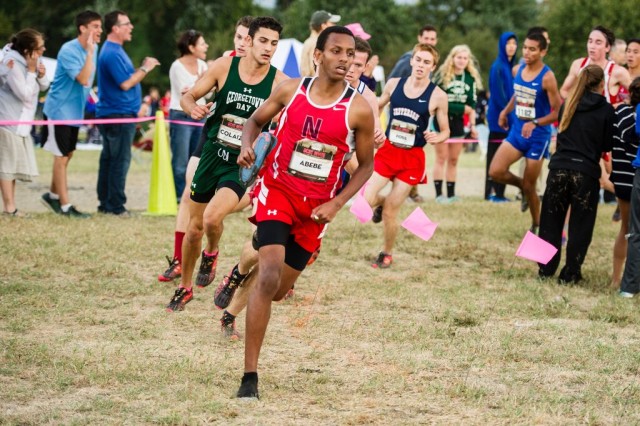
Tuscarora’s Fitsum Seyoum only took up cross-country last year. He went out for track as a freshman, he said, but didn’t like the cold weather. This has had him flying under the radar; he was not an All-Run Washington selection heading into this season. Not anymore. He had already won the Monroe Parker and Great Meadows invitationals, though an ankle injury forced him to drop out of Oatlands last weekend.
Seyoum won the senior boys race in 15:53. It was the fastest time of the day. Seyoum, though, thought of his race as more of a gusty one than a fast one. “It was very windy,” he said. “I went out and I was just saying, ‘Man, it’s going to be a rough race.'”
[button-red url=”https://www.facebook.com/media/set/?set=a.1205132242847339.1073741872.189448104415763&type=1&l=bf341ae89f” target=”_self” position=”left”] Photos [/button-red]He followed Woodson’s Robert Lockwood through the mile in 4:55. Georgetown Day School’s Tristan Colaizzi, who won the junior race last year in 15:41, was a few seconds back in 4:58. But Seyoum did not wait for the track to get moving. “I decided it was going to be a gutsy day and I’d just go for it,” he said.
Lockwood finished in 16:03. Colaizzi moved ahead of him to get within striking distance of Seyoum and crack 16 minutes: 15:59.
For Colaizzi, this DCXC Invitational was a different race than the inaugural running. “My training was different this year; I’m trying to peak later in the season,” he said. His mileage is up close to 60 miles per week – “I’m a mile, 800 guy – that’s high,” he clarified – and his goal was “just to have fun.”
As it happens, Colaizzi worked for Pacers last summer. Part of his experience was learning about the work that goes on behind the scenes and on race day to stage a high school cross country invitational.
“So, just for me,” he said, “that’s a big honor …
“Virginia has their big invites. D.C. has one now.”
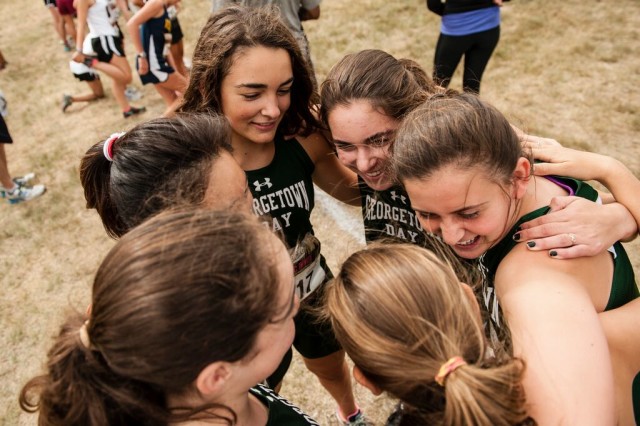
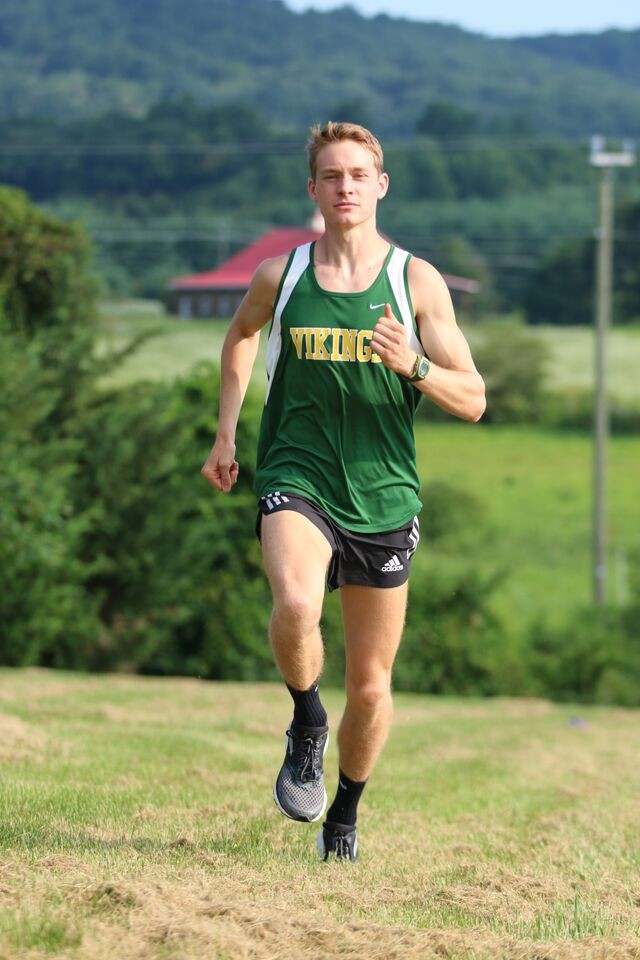
Marc and Joan Hunter, the head coaches at South Lakes High School, knew they had a superstar.
They marveled as this kid finished second in the state in cross country. They watched in awe as the freshman — a freshman — went on to win the two mile in the spring.
Marc and Joan had met through coaching. Marc was then in his 10th year at South Lakes and Joan had joined him there after getting her own start at James Madison High School.
Marc had been an All-American who had discovered a passion for coaching after being sidelined by injuries. Joan had been a successful middle distance runner with a background in exercise physiology who came to enjoy coaching more than her own running.
This is to say that the Hunters were pretty pumped to have a kid, like Alan Webb, who was “off the charts,” said Marc. “We were just going [crazy]” thinking about his potential. The thing was, the Hunters had other kids, too: three of them, all toddlers. Thus, their dilemma.
“There was just no way to be good parents with three toddlers and be good year-round coaches,” Joan said, reflecting on their decision to retire from coaching after Webb’s freshman year.
“Everyone was telling me I was nuts,” Marc said, who helped hire Scott Raczko, his and Joan’s replacement. “I thought I was nuts. But family comes first.”
In his senior season Webb would become the fourth American high-schooler to break four minutes in the mile and the fastest prep miler of all time. His run of 3:53.43 at that year’s Prefontaine Classic shattered a record, then held by Jim Ryun, that had stood for 36 years.
The Hunters had missed their shot.
Or maybe they hadn’t.
If you had gone to a South Lakes practice in 1997 or 1998 you certainly would have seen a freshman-year Webb zipping through a workout. You also might have seen, somewhere on the periphery of it all, a kid playing in a sandbox.
This was Drew Hunter, Joan’s and Marc’s second child. And Drew is now a rising senior at Loudoun Valley High School. And Joan and Marc are now Loudoun Valley’s cross country and track coaches; they’re heading into the third year of their second coaching career. And Drew, as it turns out, is now something of a superstar himself.
This year he might even become the eighth American high schooler to break four minutes in the mile. Or the first boy from Northern Virginia to win the Foot Locker Cross Country Championship.
(Editor’s note: he was)
Discovering the point
Marc and Joan Hunter have nine children, including five whom they adopted. They’ve encouraged their children to play a sport to stay active, Joan said, and all of them have done at least some running, but none of have taken to it like Drew.
But he didn’t take to the sport right away. Or at least he did not like it right away. When he was 9 or 10, Drew participated in youth track. He broke three minutes for 800 meters, which was pretty impressive, except he hated every step of it.
“I remember him coming up to us one time after winning some races and saying, ‘Can I talk to you guys?'” Marc said. “[Drew said] ‘I really don’t like running. I know I’m good, but I don’t like it. It’s too hard. I don’t want to do this anymore.'”
Marc continued: “We just went, ‘Oh, gosh, we don’t want you to run if you don’t like it. That’s why we coach. We love the sport. It doesn’t mean you have to love the sport.'”
So Drew quit.
“We just didn’t make him run ever again,” Joan said. “He was such a good athlete there was no reason to make him run track, just to be active. He was playing basketball and football and baseball and he was good at those things. We just said: ‘you do what you want to do.'”
He did, however, have to run a mile in gym class. But even after clocking around 5:20 as an eighth grader, Drew still wasn’t digging it.
At that time, he said, “I just kind of assumed if you were good at it you had to do it, and that’s kind of why I did it.” Running for Drew was like a Plan C, “something for people who could not do another sport,” Joan said.
His parents were surprised, then, when Drew told them he was going out for cross country. This news broke about a month before the start of cross country season, after which “I trained like three days a week, running 30 minutes just like every other day, jogging,” Drew said.
His attitude, his parents said, was not impressing them much, either.
“We actually kind of tried to talk him out of doing [cross country] before ninth grade … because we love the sport [and] we kind of got tired of hearing him put the sport down,” Joan said. “We were like, if you think it’s so stupid, don’t do it.”
Marc, on the other hand, was “ecstatic” when Drew placed seventh in Loudoun Valley’s time trial, positioning himself to make varsity. The team had not exactly been a powerhouse in recent years, but Marc still found the result to be encouraging. “Obviously, little did I know what was about to happen,” he said.
In the first meet, Drew was Loudoun’s number three. By the fourth meet he was the best on the team. He might have even qualified for the state meet had he not gotten sick the week of regionals.
When basketball season rolled around, and Drew rolled his ankle, the family saw how his priorities had rapidly turned. His dad met him in the locker room to help him tape the ankle and heard the words, “I’m quitting.”
Marc recalled: “And I said, ‘No, you can’t quit; it’s the middle of the season!’ He said, ‘No, I mean after this basketball season, I’m done with other sports; I’m just going to concentrate on cross country and track.'”
“I felt like,” Drew said, “if I started training more seriously, especially ran every day and started actually putting forth the effort that I put into other sports, then I could probably be decent at it. And I think that the next summer” — after making all-state in the outdoor two mile — “was when I took off because that was when I really caught the running bug.”
In the fall, Marc and Joan, seeing their son transformed and wanting to make sure he got good coaching, took over Loudoun Valley’s cross country and track programs. Drew, meanwhile, won his first cross country state championship.
Penn Relays 3,000m High School Championship, 2014
It was a huge field and the start was hectic. The boys shot out, lurching. Drew Hunter, on the rail, seeded 14th facing the best high schoolers in the country, reached out and put his hand on the back in front of him to stay balanced. The kids behind him did the same to him.
The announcers on Flotrack, during the first lap, said he was from “Luden” Valley. They said this as you saw him shoot out to the second lane and squeeze past two guys to stay in the middle of the pack.
Early in the race there were times he would fall out of the picture. Lap by lap, though, he moved up a little more through the pack — his form more athletic than classic; his posture very upright; his head bobbing a bit. (Was he hurting or not hurting at all?)
At the bell lap Hunter was there at the front. With 300 to go, he made his move, kicking into the lead.
It looked like he had it won, too. But then Justyn Knight, of Toronto, threw in a big surge and pulled up next to him and it looked like Knight might roll him.
As soon as Knight pulled up next to him, though, Hunter responded with a savage surge and rocketed ahead in the final straight. Oh my gosh – what? WHAT? Hello! Those were the words from the FloTrack broadcast announcing that Hunter had run 8:16.31, a new sophomore class record, and had won with a ridiculous kick.
“That was the first time I ever had a kick, ever — and after that it’s what I can trust and rely on,” Hunter said.
In one race he had established himself as one of the top high school runners in the country and had dialed in on a very simple race strategy going forward.
“Going into races my mindset is to win,” he said. “And if I win, then a good time, good result will come… It’s not complicated. It’s not try to run this split and this split on the second lap. It’s really just put yourself in a position to win on bell lap.”
Hunter, in his sophomore season, won state mile and two mile titles and was runner-up in the two mile at the New Balance National Outdoors meet. He also ran 4:09 for 1,600 meters.
The Drew Project
Marc and Joan Hunter had last coached during an era in American distance running that valued low-mileage, high-intensity training.
There is a reason that the United States squads for the 2000 Olympic marathon were each teams of one. “We just did not have good distance runners for the most part,” said Joan, who writes Drew’s workouts.
Joan’s own philosophy about training changed when she turned to Tom Schwartz, perhaps better known in the LetsRun.com world as “Tinman,” for advice on competing in masters track.
Joan, as it turned out, liked nothing more than doing a dozen really-fast 200s. Schwartz had other ideas, like running more miles, doing longer intervals with shorter rest periods, and doing tempo runs. Joan, in turn, started running some of the best masters times in the country at everything from 400 meters to 5k. And Schwartz now helps write Drew’s training, as well.
Drew ran about 65 miles per week last year, rarely resting before races. This year he aims to run about 70 miles per week.
“It’s not what I would call high mileage,” Joan said, “but it is certainly more than I ran in high school.”
Meanwhile, for someone who begrudgingly took up cross country, Drew has been quick to adjust his lifestyle. He credited his leap in his performances during his sophomore year to consistent training, eating better, and sleeping more. “I think when you are training at a high level you have to do the little things,” he said.
For Drew, doing things right also can mean training alone, though he noted that some of his best friends are his cross country teammates.
Doing things right also meant staying in Loudoun County recently while the rest of the Hunters went on a vacation to the beach. First, he isn’t a fan of running on the beach. Second, he had just started his summer training and was eager to get back into his routine.
“I wanted to keep the ball rolling,” he said. “I kind of wanted to focus and make training the priority.”
Part of what has Drew so focused is the realization, really, that if his parents can do it, he probably can, too.
When he was growing up, he would watch his mom compete and see how good she was. His dad, who could not run after 23, only had stories and times, but eventually it all clicked.
“I mean, if you tell an 8-year-old your 5k PR is 13:36, you’re not going to have any idea what that is,” Drew said. “Once I started running freshman and sophomore year, I realized how good my dad was. That also kind of gave me more motivation to go after his PRs and try to be as good as him.”
Brooks PR Invitational 2 mile, 2015
In his junior year appearance at the Penn Relays Drew Hunter won the mile in 4:07, becoming the first prep runner since Matthew Centrowitz to win both of the event’s individual distance races.
Prior to the Brooks PR Invitational he had lowered his mile best to 4:02.36. This is in addition to winning everything in Virginia there was to win, including running 14:36 to set a meet and course record in the state cross country meet.
Frankly though, heading into June’s Brooks PR Invitational, in Seattle, some thought Grant Fisher, from Michigan, was unbeatable. Fisher had recently become the seventh high school runner to break four minutes in the mile. He had not lost to another high school runner in years. That included a healthy margin over Hunter, who was fourth at last year’s Foot Locker Cross Country Championships, one of the deepest high school championships in history.
It looked at times like Fisher was just cruising along, floating behind Mikey Brannigan through the mile in 4:24. He is a lean yet powerful runner with seemingly perfect arm swings.
The last time they had raced, Hunter was right with him with 200 meters to go. Fifty meters later, though, he got tripped up and couldn’t make up the gap. It was disappointing for Hunter but also instilled in him the belief that he could be the one to break Fisher’s winning streak. This time, he would use the same race strategy: kick with 400 to go; try to accelerate every 100 meters; in the stretch “just outrun him.”
With 600 to go, Fisher moved into a clear lane and seemed to be biding his time. Hunter’s game was cat and mouse: he was out in lane two off Fisher’s shoulder. At the bell he popped out a little further into lane two to get some space and then he went, bolting, Fisher closing right with him. The rest of the field disappeared. It was Fisher and Hunter, hammering, strides overlapping in a way that conjured that mystical Tergat–Gebreselassie moment. This was anyone’s race. And there was 100 to go. There was 50 to go … and Hunter, like at Penn, found that gear and blasted ahead, winning in 8:42.51, by a second.
“Grant’s one of my good friends,” Hunter said. “He’s a great guy, and he’s one of the guy’s I’ve looked up to.” Which is nice sportsmanship. But Hunter, too, is a sportsman. Competing is what makes him tick.
He then said: “But I think it’s necessary. Track and field needs rivalries. I am excited to race him again in college. It should be a blast.”
Hunter might end up being number eight. But it also seems like he’ll need a race to win to do it. And that’s a good thing.
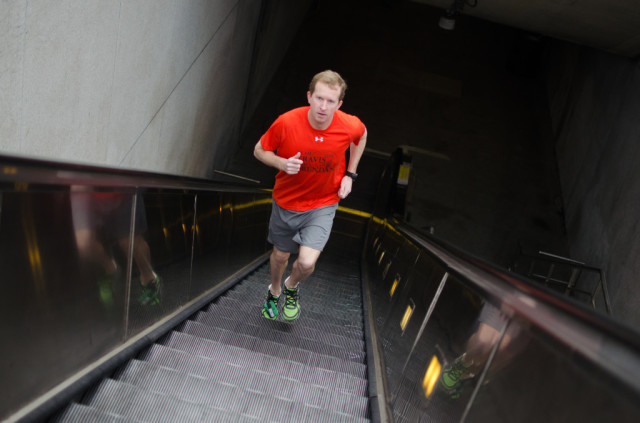
It’s a Sunday morning in December, a few minutes past 9. The weather is gray and cool and still, perfect for running.
RunWashington Editor in Chief Charlie Ban and Patrick Benko, who is 32 and a relatively recent running convert, meet at the chosen starting line: the gates to the Van Ness Metro station in Northwest Washington, D.C.
A train bound for Glenmont takes them both by surprise when it pulls into the station, Charlie yells out, “GO!, GO!” And like that, they split – Charlie, with his notebook, down the escalator towards the platform; Patrick, dressed to run, up the escalator towards the street.
The finish line is the entrance to the Foggy Bottom station, where escalators meet sidewalk.
To be clear, this race is not in any way intended to be some sort of commentary on D.C.’s Metro. This was just a little experiment – a bar bet, if you will. We wanted to make the race as fair as possible, to set a good example for runner safety, to obey all Metro rules (at least the ones we are aware of), and, lastly, gain a heightened sense of how – on the weekend, anyway – steel wheels on rail compare to sneakers on pavement.
Patrick faces about three and a half miles of sidewalks, and has agreed to obey all stop signs and traffic signals.
Charlie, in turn, faces roughly 20 to 30 minutes of public transiting. That includes five stops on the red line to Metro Center; a transfer; three stops on the Orange-and-Blue line to Foggy Bottom; and a controlled hustle (no running in the Metro!) from the platform to the street.
Patrick has a 5k personal best of 20:02. Charlie, well, Charlie has a rapid transit system that much of the time really is.
So, before we go further with this, place your bets. Who will win?
Man or runner?
Patrick on foot or Charlie via Metro?
Actually, before you get serious about your bet, let us tell you more about our competitors.
Patrick Benko, you should know, has already beaten the Metro at least once on foot. One of those times occurred on a Wednesday morning in September, when power failures caused major delays on Metro’s red line, which Patrick uses to commute from Shady Grove (near his home in Gaithersburg) to Chinatown (the closest stop to his job at the American Public Health Association, where he specializes in online marketing).
While some Metro riders were forced to evacuate the red line that day in September, Patrick’s decision to evacuate in Friendship Heights was entirely his own. Why not? He planned to run during his lunchtime, anyway. So rather than make like a sardine in a crowded train, he exited the station and took off running. An hour later, Patrick was at his desk and the train was still stuck in the tunnel. And, Patrick had already gotten his run in.
As it happens, Patrick runs about 30 miles per week, and has made exiting the red line to go running a regular habit.
In fact, according to Patrick math, one minute on the train equals two minutes of running.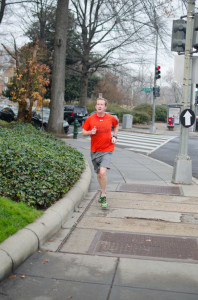
And seriously, who reading this magazine wouldn’t want to trade 30 minutes of commuting with an hour of running?
Sometimes he gets off the Metro in Bethesda and runs down the Capital Crescent Trail. Other times, he gets off at Van Ness and runs south on Connecticut Avenue. He carries his work clothes in a Camelbak backpack; on his off days, he carries an extra set of work clothes to lighten his load on the days he runs. He showers when gets to work. And, with good planning, Patrick attests, side trips to Macy’s to buy a belt before the big meeting are easily avoided.
Patrick emerges onto the streets outside Van Ness, starts his watch, and takes off running South on Connecticut.
This is the runners’ hour, when the streets are practically empty, when it’s quiet enough to hear birds. There are enough hours between now and brunch, you figure, that many hangovers have yet to be realized. The car horns have yet to return. The sidewalks have yet to fill up. And the city, at least for now, feels like it’s all yours.
Patrick is running comfortably hard and steady, a couple minutes off his 5k PR pace.
Occasionally, he passes by a runner heading north. He passes a contemplative soul taking a picture of a tree with his phone. He passes people milling about with their coffees. “On your left,” he shouts, as he passes a young man dragging a rolling suitcase.
You can hear the whine of the escalators as he passes the Cleveland Park station. Pretty soon he’s cruising past the Woodley stop.
Crossing the Connecticut Avenue Bridge, his eyes stay focused on the road ahead, his memorized route – not the trees and water and running paths of Rock Creek Park far below.
He had done a test run of his route on Friday morning – at a time no doubt, when the Metro would have been harder to beat.
But he’s having one of those city runs today where everything seems to be conspiring in his favor. In other words, he’s catching all the walk signs. It’s not until Calvert, in fact, that he has to come to a complete stop, and even then it’s only for a second or two that only seems to refresh him a bit before he surges on.
This race is neck and neck.
And below ground, previously-unthought-of-efficiencies of weekend Metro riding reveal themselves: like the absence of people ignoring warnings to, as it goes, stand clear of the closing doors.
Charlie is loving it. He has two seats to himself. He has a newspaper to read. Dude’s content.
But he’s also alert. He knows his transfer in Metro Center is critical. He won’t have much time, you see, to hit a quick transfer to the Orange- and-Blue that could more or less guarantee himself a perch on I Street, where he could stand there reading his Kindle and pretend not to even notice Patrick entering his kick as he turns off Washington Circle.
Entering the Metro Center platform, he heads to the nearest escalator. It seems, at first glance, that everyone is standing on the right side. But it only takes one, and one there is. On his way down the escalator Charlie sees the train pulled up to the platform, doors open. Charlie clears his throat; it doesn’t work. Finally, he says out loud, “walk, please,” which doesn’t work, either.
He reaches the bottom of the escalator just as the doors close. Making matters worse, as the train pulls away, he looks up at the
board and sees “14 minutes,” like some grossly positive split that has no doubt doomed his race.
He takes a seat on a granite bench and sulks, thinking about all the ground Patrick is covering above.
But wait! Charlie almost got on the wrong train! The right train is only a minute away!
This race is back on!
Charlie clocks an 8:47 transfer. Now he’s back on the train, moving again, confident.
Patrick, meantime, hangs a smooth right on Florida, gliding between a small group at the corner. He spots a walk sign and, after looking both ways, darts through a crosswalk.
He crosses Mass Ave. He’s on 22nd bound for K Street and Washington Circle, the end in sight.
All of this would have seemed so improbable just a few years ago.
Patrick had played sports in high school and college. But for a decade after that, he was largely inactive, and a smoker.
He quit smoking in 2010. That year, he also started training for the Marine Corps Marathon so he could run it for Team Travis and Brendan, which raises money for the Travis Manion Foundation.
Marine 1st Lt. Travis Manion and Lt. (SEAL) Brendan Looney were best friends and U.S. Naval Academy roommates who both made the ultimate sacrifice. Patrick attended high school with Looney.
Even so, Patrick says, were it not for his wife, Jackie Benko, he could have been a one-and-done marathoner. When
he joined Montgomery County Road Runners’ first-time marathoners group in 2010, Jackie joined, too – figured she’d keep her husband company. Now they’ve run MCM three years in a row, and Patrick has his sights set on the upcoming Rock-n-Roll USA Half Marathon.
As he double-steps the Foggy Bottom escalators, Charlie is sure victory is his. But as he gets closer to the street, he recognizes Patrick’s bright-orange Team Travis and Brendan shirt, and, at the top, graciously accepts his defeat.
Patrick, according to his watch, has covered 3.34 miles in 22:24, with less than 15 seconds of that spent not running. He hit an average pace of 6:43 per mile, just as he said he would.
Charlie, and the Metro, they had a good “run,” too, coming in only about a minute behind.
But for Patrick, with three marathons under his belt now and a new year approaching, the win is sweet – confidence boosting, even. He has a good story, maybe one that will inspire future generations.
On a Sunday morning in December, Patrick Benko laced up his shoes, took off running, and beat the machine.
He also got in a solid tempo run.
Two years later, D.C.’s Alison Meek attempted a shorter but less complex challenge- sprinting between the Federal Triangle and Smithsonian stations to see if she could catch the same train, after .4 miles of running. Her 3:36 time wasn’t enough, but she caught the train immediately following the one she disembarked.
You can see the video she and friends made here.
This story originally appeared in the February/March 2013 issue of RunWashington.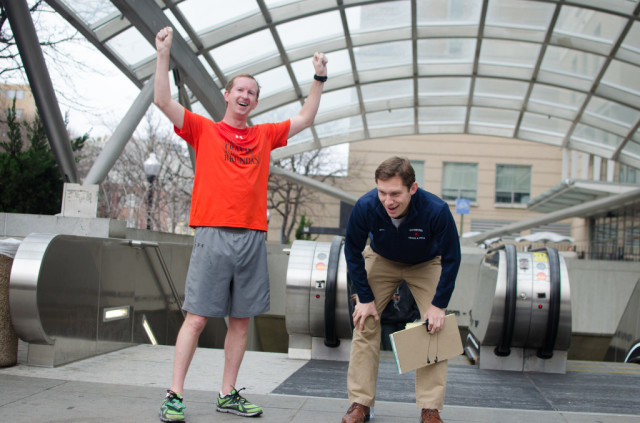

The word Brian Shrader kept saying over and over – to reporters, to friends, to race organizers, and to new fans seeking his autograph – was “shock.”
For example: “I’m still in shock,” he said, after winning the .US National 12k championship in Alexandria this morning. “I don’t even know what to think.”
[button-red url=”http://www.national12k.us/Results.aspx” target=”_self” position=”left”] Results [/button-red]
There were a number of reasons Shrader felt this way.
For one, the top prize paid out $20,000, but the 23-year-old still has track eligibility left at Northern Arizona University. So unless he wants to turn professional, Shrader, according to NCAA rules, can only accept prize money “in an amount up to actual and necessary expenses for the calendar year.” (See this Collegiate Running Association page for a more detailed explanation, but he could keep as much as he can document with receipts, including costs for travel, equipment and coaching.)
Before today, Shrader had never run a 10k, let alone a 12k. He had only run one other road race: the CVS Downtown 5k, the national championship, in September, where he was 4th in 13:59.
Shrader racing the 5k was Northern Arizona University alum Diego Estrada‘s idea. They both live, and occasionally train together, in Flagstaff, Ariz. That day, Estrada unleashed a strong kick to win his first national title, while Shrader qualified to have his expenses covered to compete in the 12k.
On a cold, overcast morning, Shrader, Estrada, and 22 other elite men started around 7:25 on S. Union Street, near Oronoco Bay Park. They headed south to Franklin Street and made a short climb and descent. There, not long after the mile mark, they turned left onto George Washington Parkway, which they followed out to the halfway mark, where they did a U-turn and retraced the same route.
Last year, Aaron Braun, of Alamosa, Colo., came here hungry to win his first national title, setting the tempo for a big lead pack and throwing in a series of surges that allowed him to gradually slip away. He broke the tape in a time of 34:26, which he found out later was just two seconds slower than Steve Spence’s American record.
At yesterday’s press conference, Braun said he was just as fit, if not more fit, than he was in 2013, but also knew he’d have more of a “target on his back.”
That turned out to be true.
In the opening mile, a huge pack, 20-plus strong, formed around him. The consensus, it seemed, was that Braun would be the one pushing the pace while everyone else would be the ones trying not to get dropped.
As 4:40s in the early miles dipped down closer to 4:30 by halfway, the pack started to string out. After the U-turn, Braun threw in a 4:25, his goal being, as with his earlier and later surges, to “try and hurt people a little but also not hurt myself.”
“I needed to be able to put them away earlier,” Braun said, “and make them think it was too big of a gap.”
But back on S. Union Street, when the finish line came into view, Braun, though he had successfully dropped most of the field, was still flanked by five other runners – Shrader, Estrada, Jared Ward, Girma Mecheso, and Parker Stinson – who were snapping out of survival mode and tapping into a far more positive notion: I can win this thing.
Shrader, wearing his NAU singlet, had been executing his strategy of keying off Estrada, hanging on to the lead pack as long as he could, and waiting to see what he had in the end. In the final miles, he tucked closely behind Braun. The last 200 to 300 meters, for him, and for everyone involved, was a blur.
Shrader took the lead; and when his legs tied up, 50 meters or so before the finish, he expected to get caught, but no one came. He won in 34:11, averaging 4:35 per mile, as all six in the final chase pack dipped under what used to be Spence’s American-record time.
Estrada, who had given Shrader the idea to test out road racing, and who missed training time recently due to a sinus infection, was just a second back in 2nd. He said the race played out as he expected.
“I assumed Aaron would push the pace, which happened. And then I figured there would be a few guys with a mile to go; then of course everyone would charge again … But I hesitated a little bit. I wasn’t quite feeling it, and it cost me at the end because I ran out of room,” he said.
Braun, just three seconds back, returned to the podium. “My goal, he said, “was to come back and get the title, number one, and get the record for number two. I got number two, but not number one.”
Mecheso, 5th, gave Braun credit: “The way he ran, he deserved to win,” he said, “because he was pushing all the way.”
Stinson, two seconds behind Mecheso, was inspired by the result, calling it “one of my best races.” Like Shrader, he still has track eligibility, though at University of Oregon.
On one hand, he would’ve liked to have been more competitive during the sprint finish. On the other, he doesn’t envy Shrader.
“I’m glad I didn’t make too much money,” he said, “so I don’t have to make any decisions.”
***
Falls Church native Christo Landry knew his odds of winning his fourth national title in 2014 weren’t good. Five weeks ago he finished 13th in a new personal best of 2:14:30 at the Chicago Marathon, and was still feeling its effects. “I just don’t have the top-end gears right now, coming off the marathon,” he said after finishing 8th in 34:42. “And when you get dropped running 4:35, right after running a 4:32, [you know] they’re running a great time. They ran great, and I just wasn’t hanging with them today.”
For Landry, through, today’s 12k was also a way to celebrate a breakthrough 2014 that gave him an insurmountable lead in the USA Running Circuit (USARC) standings. After the top 10 men were announced, Landry was awarded the $25,000 overall USARC title. He had 82 points, 31 more than Estrada in second.
In the masters division, Arlington’s Michael Wardian won a national title in 38:32. Philippe Rolly, of McLean, was second.
“I don’t ever try to just look to win the masters, but it’s exciting to be in a new age group,” Wardian said.
In typical Wardian fashion, the ultra runner and marathoner was in the Bahamas earlier in the weekend getting in some heat training, he said, and on Friday will represent Team USA at the World 100k championships in Quatar.
“Our team is completely stacked,” he said, “so I think we should win the team title.”
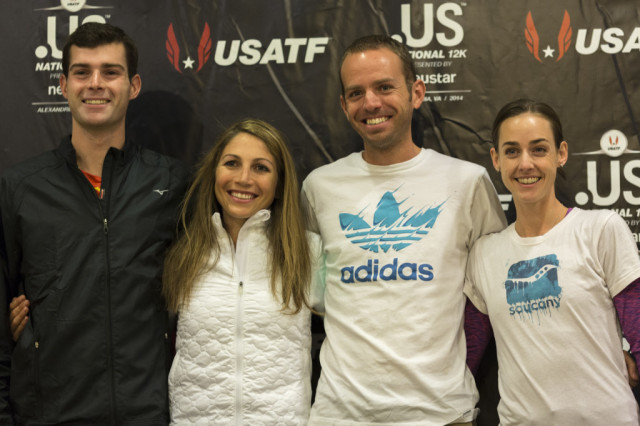
For the second year, the .US National 12K championships will be held in Alexandria, capping off the 2014 USA Running Circuit (USARC).
How it works: The USARC each year hosts national championships at distances ranging from one mile to the marathon. The first 10 U.S. runners at each race earn points, and also qualify for the 12K, which features $100,000 in prize money. Points are doubled at both the 12K and in the marathon.
***
Heading into tomorrow, Falls Church native Christo Landry, with 76 points, has an insurmountable lead in the men’s standing. Landry is entered; Tyler Pennel, second in the USARC standings, is not.
Pennel established himself on the national stage at last year’s 12k, finishing 3rd. In October, he won his first national title in his debut marathon.
For Landry, 2014 has been nothing less than a breakthrough year. In April, he won his first of three national championships on his home turf at the Cherry Blossom Ten Mile Run, prior to capturing titles at 10K and 25K. Five weeks ago, Landry was 13th in 2:14:30 at the Chicago Marathon. The result disappointed him.
Tomorrow, though, Landry, a graduate of Thomas Jefferson Science and Technology then William & Mary, who recently moved from Michigan to Charlotte, N.C., will give it his best shot, and, no matter the result, claim a USARC title and savor the opportunity to race in northern Virginia. “It’s just great to come home,” he said. “I grew up right nearby and anytime I get to come back to this area it just feels like coming home again, regardless of where I live at the moment.”
During a press conference today, Kevin Ullman of RunnerSpace pointed out that Landry and Molly Huddle have a shot at becoming the first runners to ever claim four USA titles in one year.
Landry, after noting how special that would be, said, “It’s more likely to be Molly’s chance to do it first than mine tomorrow.”
Huddle, the defending 12k champion and clear favorite, is just two points behind Sara Hall in the women’s USARC standings. Both will race tomorrow.
“That’s a pretty detailed stat,” said the understated Huddle, to Ullman’s question, “but I think it would be pretty special [to win four titles].”
Huddle has raced three USARC races and won as many times, claiming titles at 7 miles, 20K, and 5K. Last year, for Huddle, 12k, as a distance, seemed both strange and too long, even if she covered it in a national record time. This year, though, Huddle said she has a good “pace memory” for the distance and is focusing on winning a national championship. “Hopefully however fast we have to go I’m ready to do that,” she said.
Hall, throughout her career, has had tremendous success in the middle distances on the track, but said she has had fun – not to mention success – experimenting with longer distances this year. She was the second American finisher at the Cherry Blossom Ten Mile Run, which hosted the national championship, and won and set a course record at the EQT Pittsburgh 10 Miler last weekend.
Had it not been for a burst appendix in August, Hall, who is married to American marathoner Ryan Hall, planned to run her debut marathon earlier this fall. That plan has simply been postponed.
“After this race I’ll probably be turning the corner to more marathon specific training,” she said.
***
After many near misses, Aaron Braun won his first national title at last year’s 12k, “getting over the mountain,” he said.
Braun added: “Once I know that I’ve done something once, then I have a lot more belief that I can do it again.”
Braun’s 2014 has been up and down. His debut marathon didn’t go well. And in July, Braun, feeling overly fatigued, took a long break to recharge.
But Braun has since won the Great Cow Harbor 10K and San Jose Rock ‘n’ Roll Half Marathon, and is now focused on defending his 20K title. “I feel like I’m in as good of shape, if not better shape, than last year, so I should be able to pull it off again this year,” he said.
Believing gait inefficiencies contributed to his difficulties in the marathon, Braun worked on his form, starting with a visit to Mark Plaatjes, a former world marathon champion and physical therapist, for video analysis.
“As soon as I watched the video, I was kind of like, ‘Oh, gosh, that’s pretty bad.’ You always feel like you are the most beautiful runner, but when you actually see, actually critique yourself, it was kind of a good view into what was actually happening,” he said.
Braun has been doing strengthening drills and has been more conscientious of not leaning too far back while running.
“Hopefully it pays off tomorrow and in my future marathons,” he said.
***
A USATF spokeswoman said 1,300 runners will participate in tomorrow’s race. It will be run on a different, and out-and-back, course, but will start and finish in the same place, near Oronaco Bay Park. (See map.)
The elite women will start at 7:15 a.m. The elite men, masters, and open race will start at 7:25. To watch online, see the live stream.
Lucas Meyer, a lawyer living in Washington, D.C., is in the men’s elite field. See both elite fields.
RunWashington will cover both the elite men’s and women’s races. Follow @runwashington and @dicksonmercer for updates.


 Hear Dickson Mercer talk about our local qualifiers on Pace the Nation
Hear Dickson Mercer talk about our local qualifiers on Pace the Nation